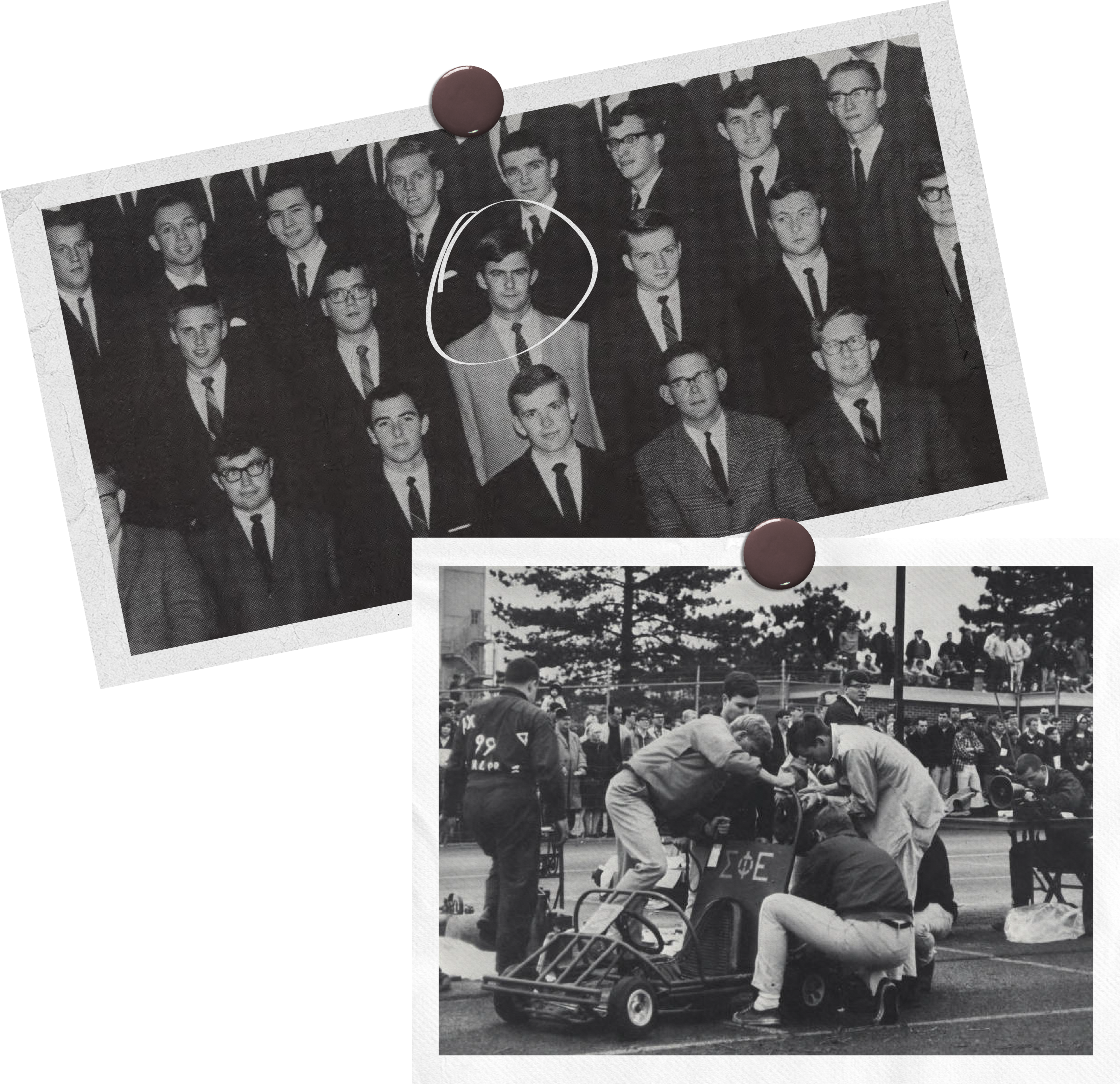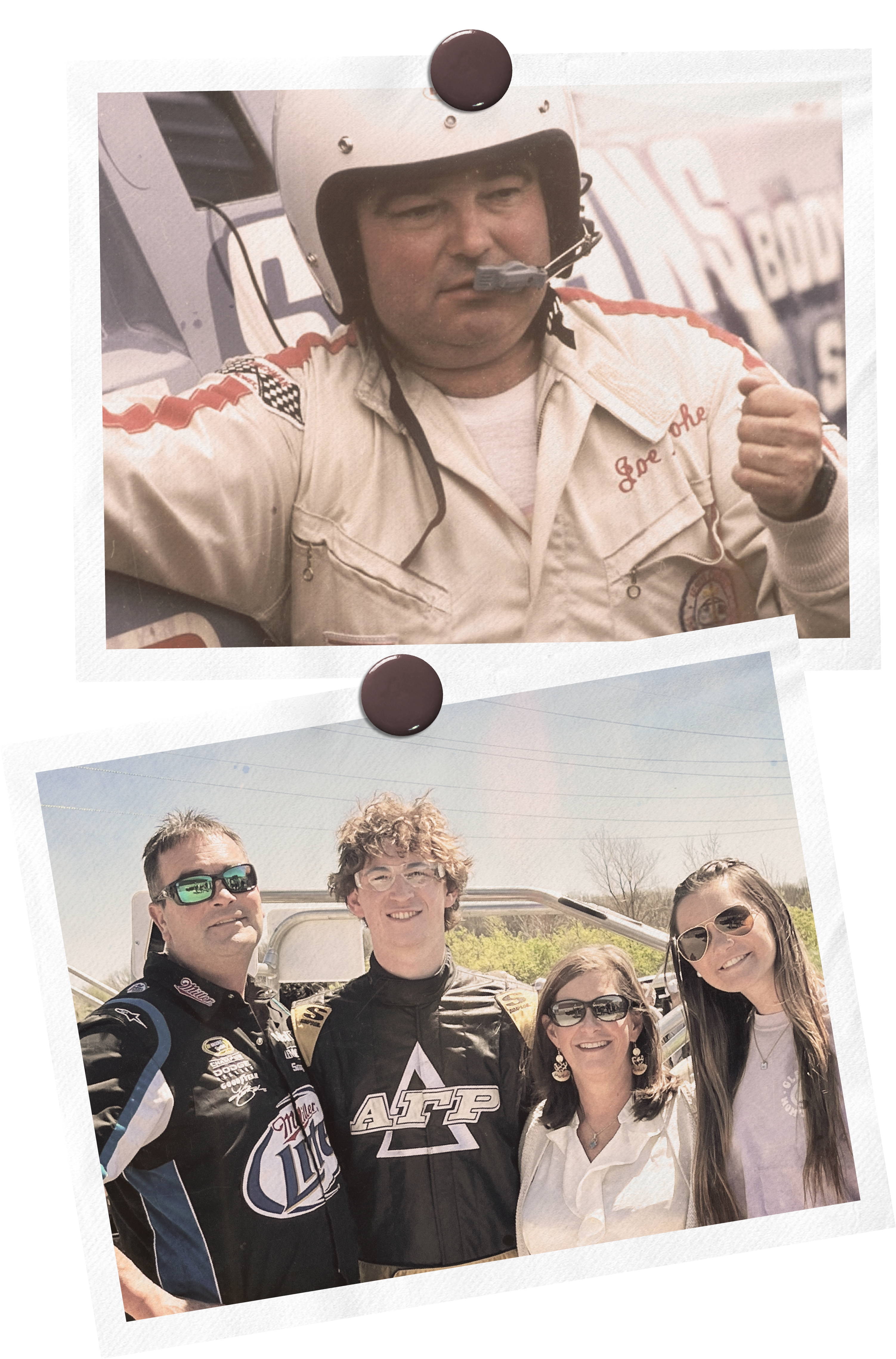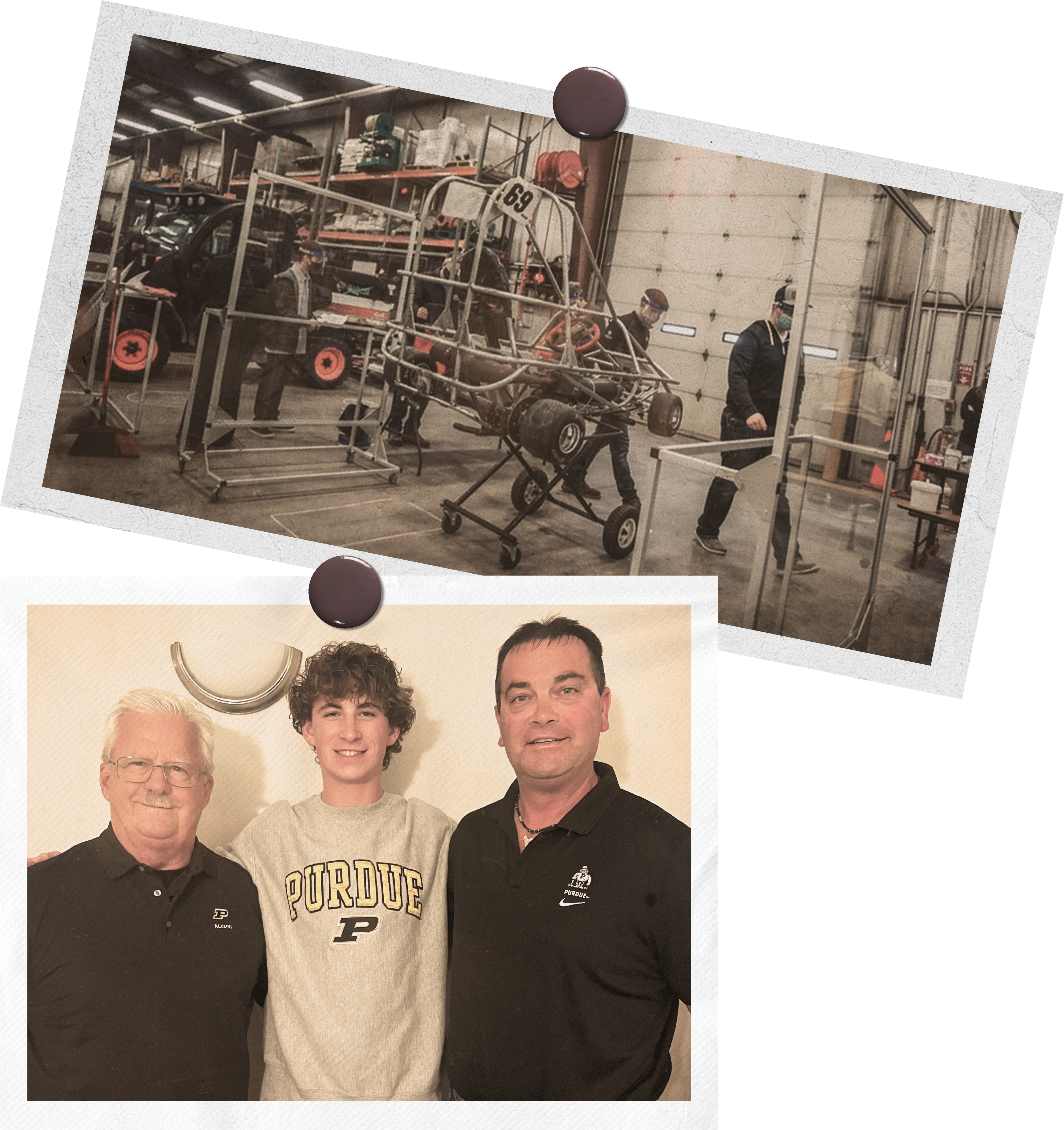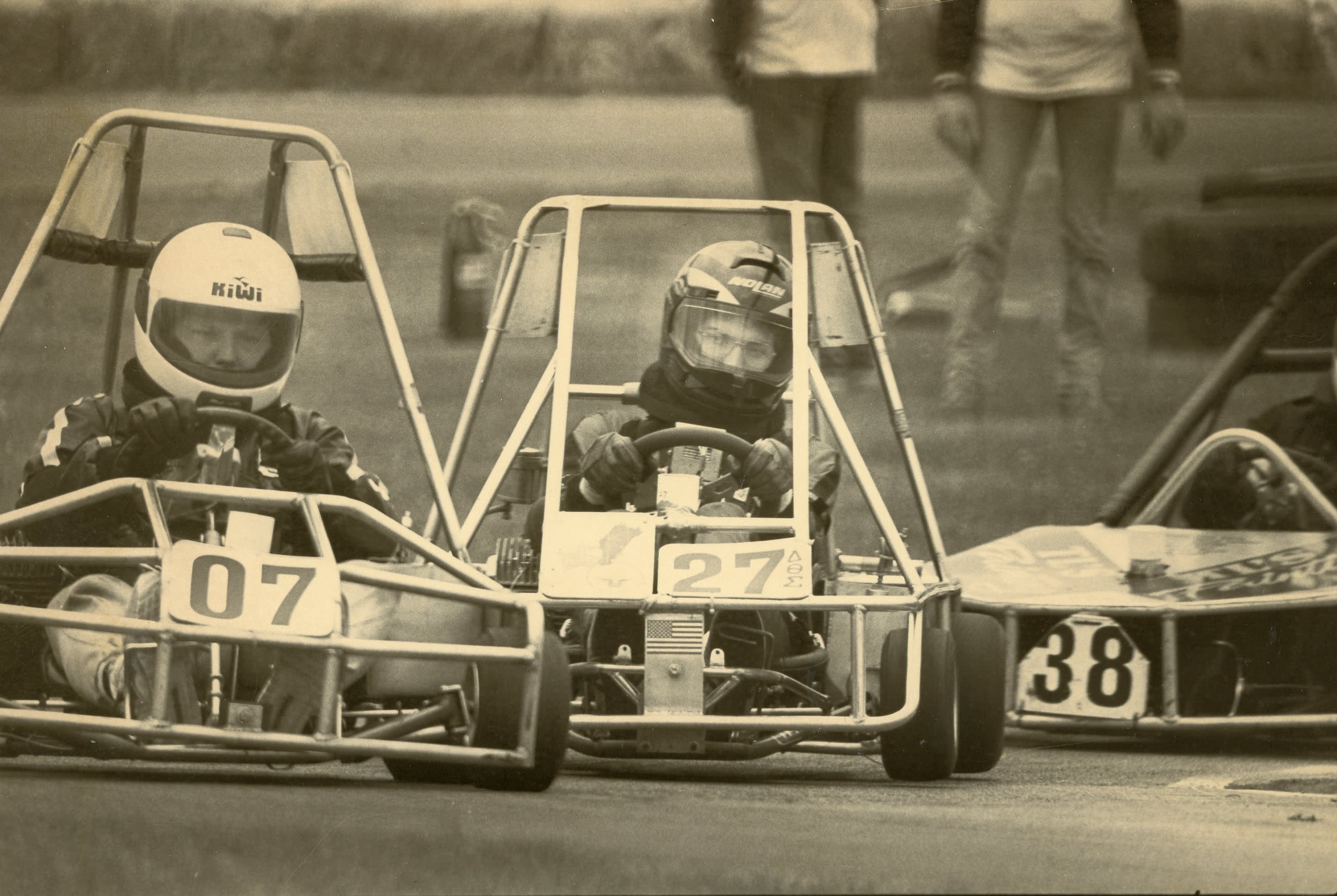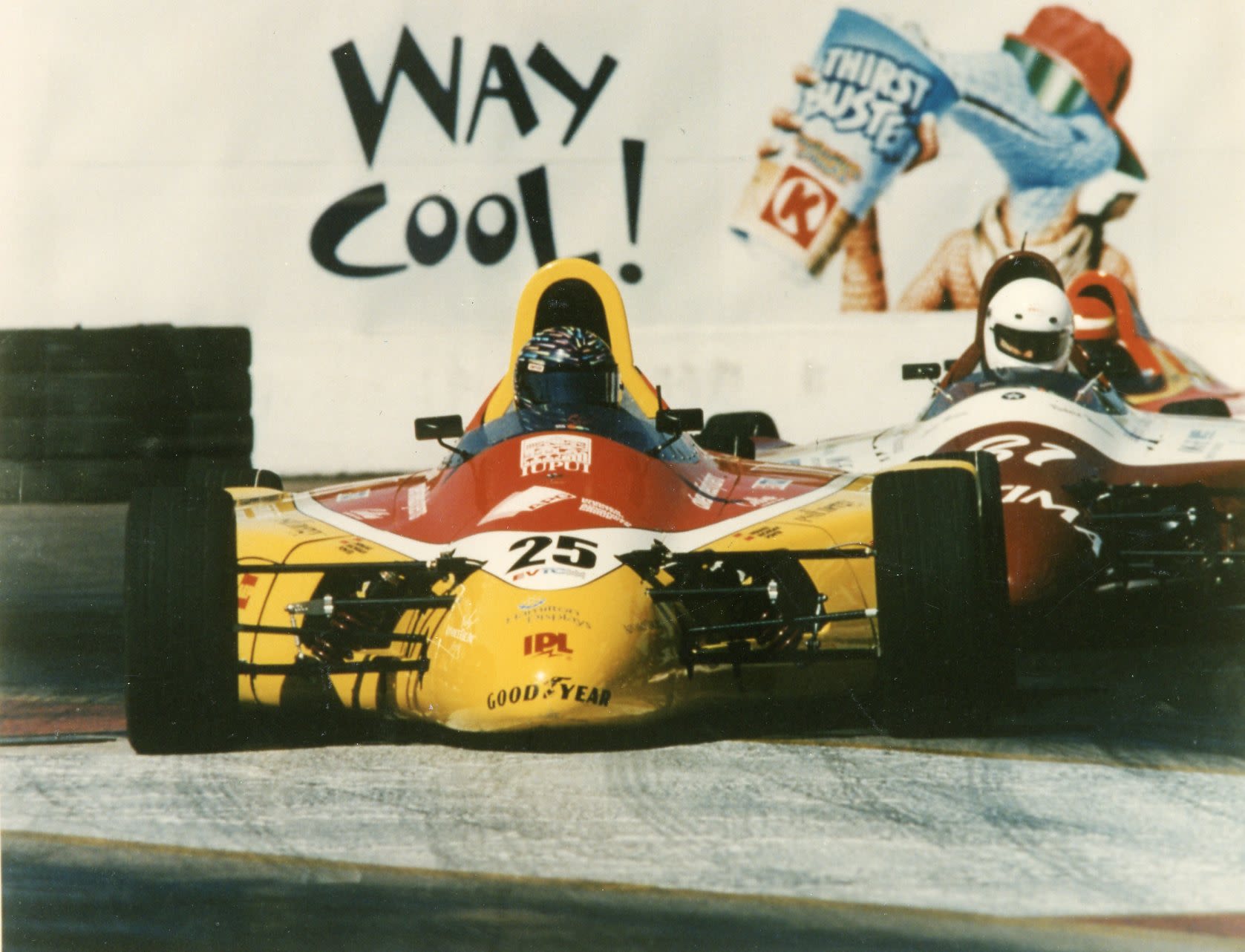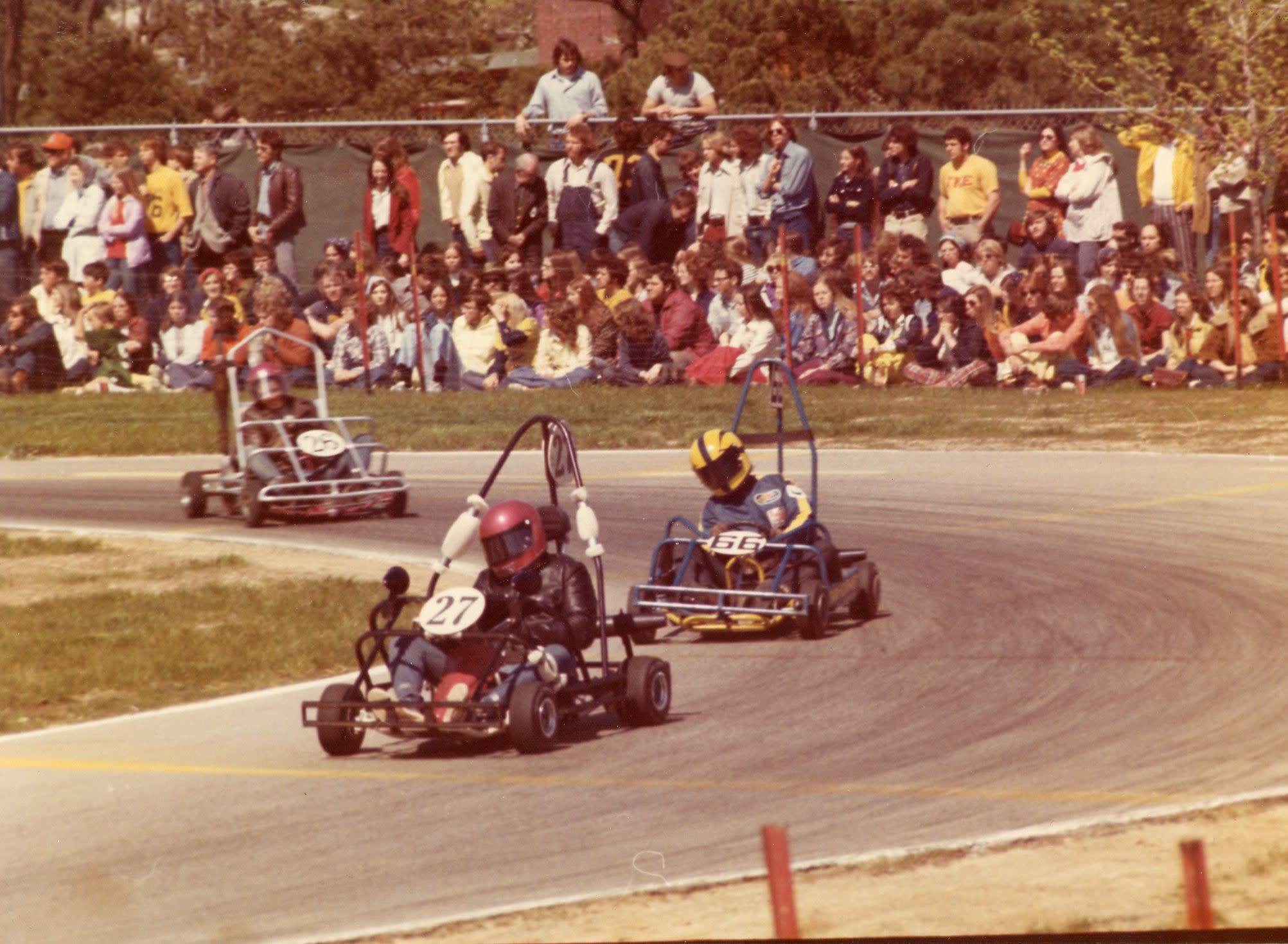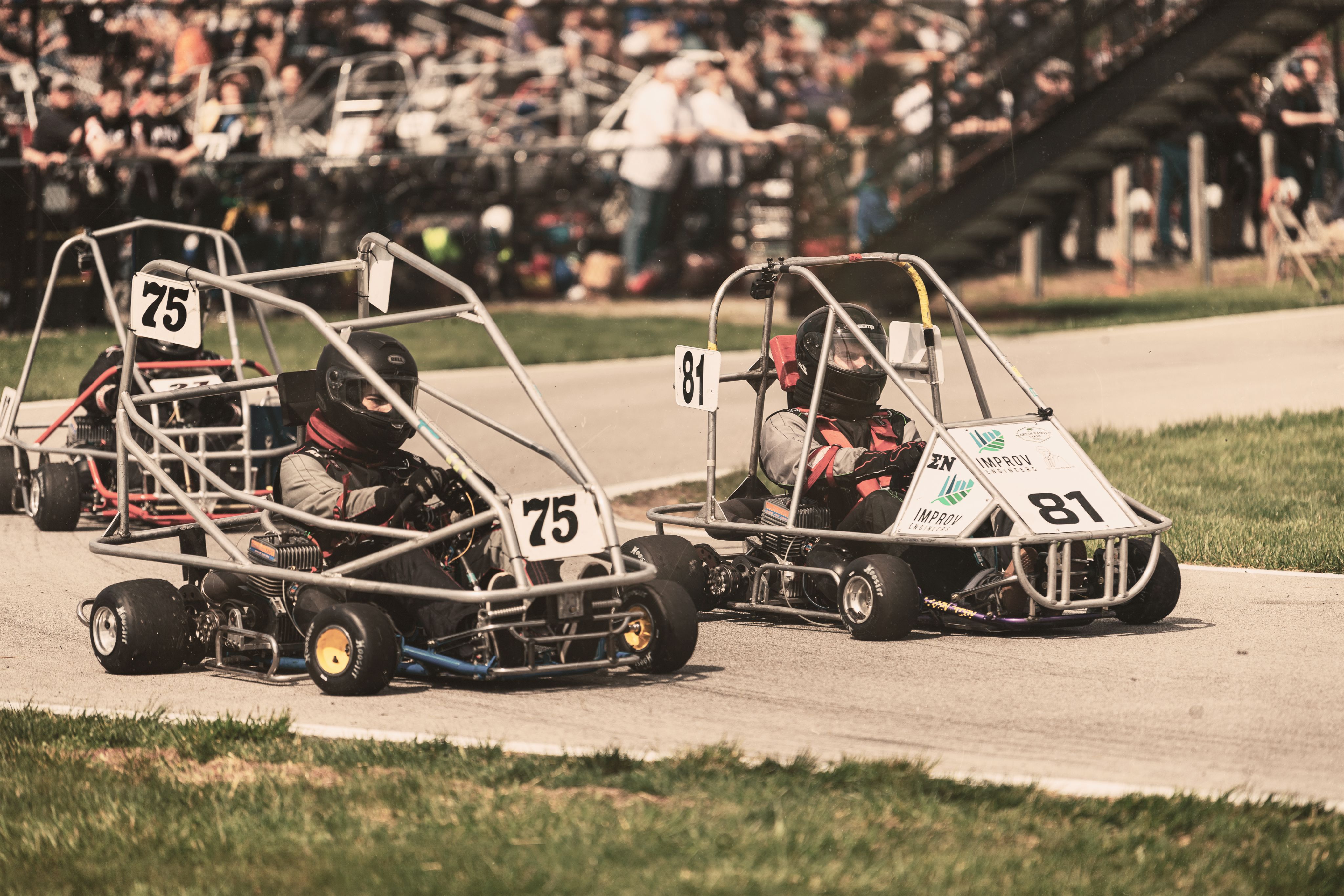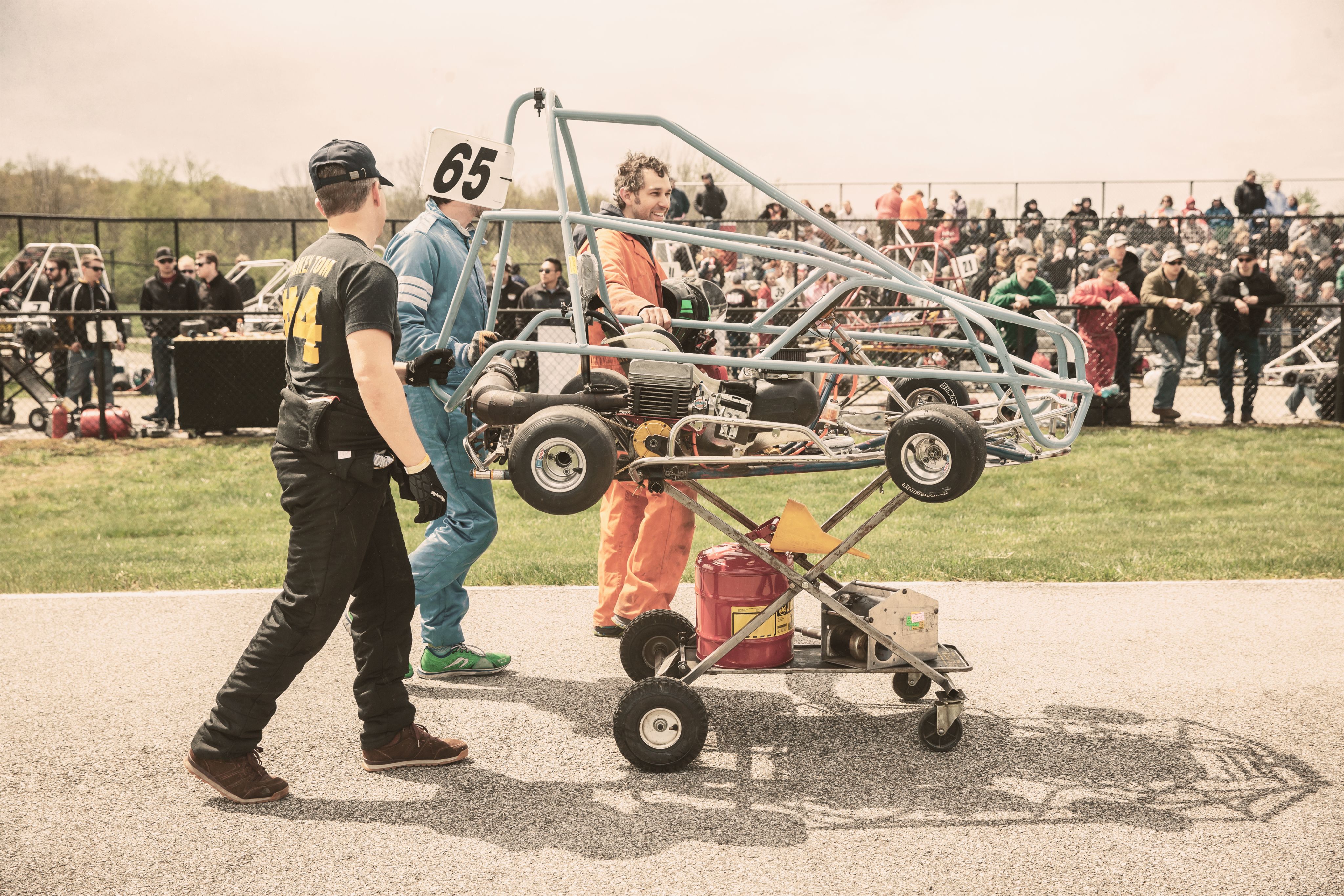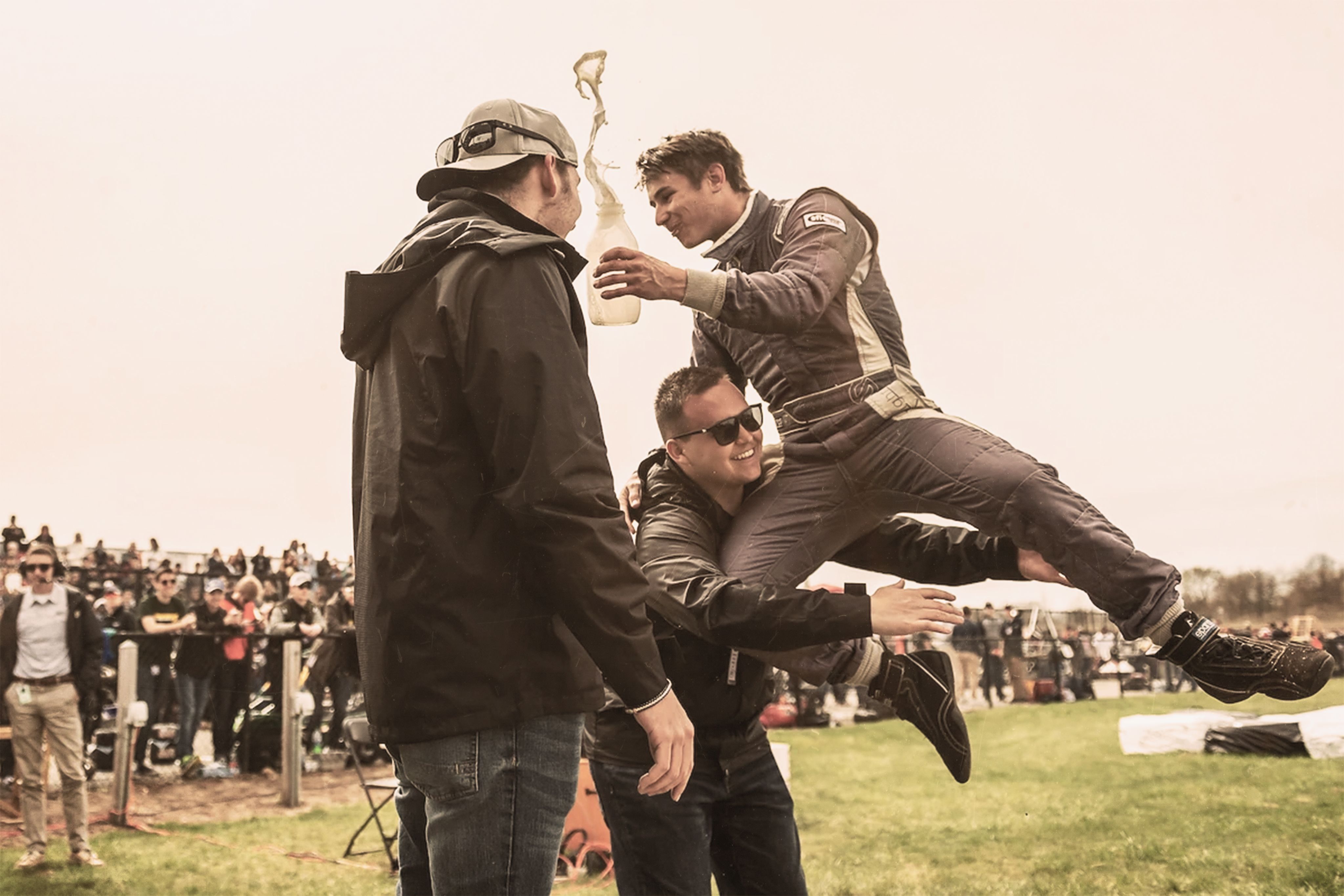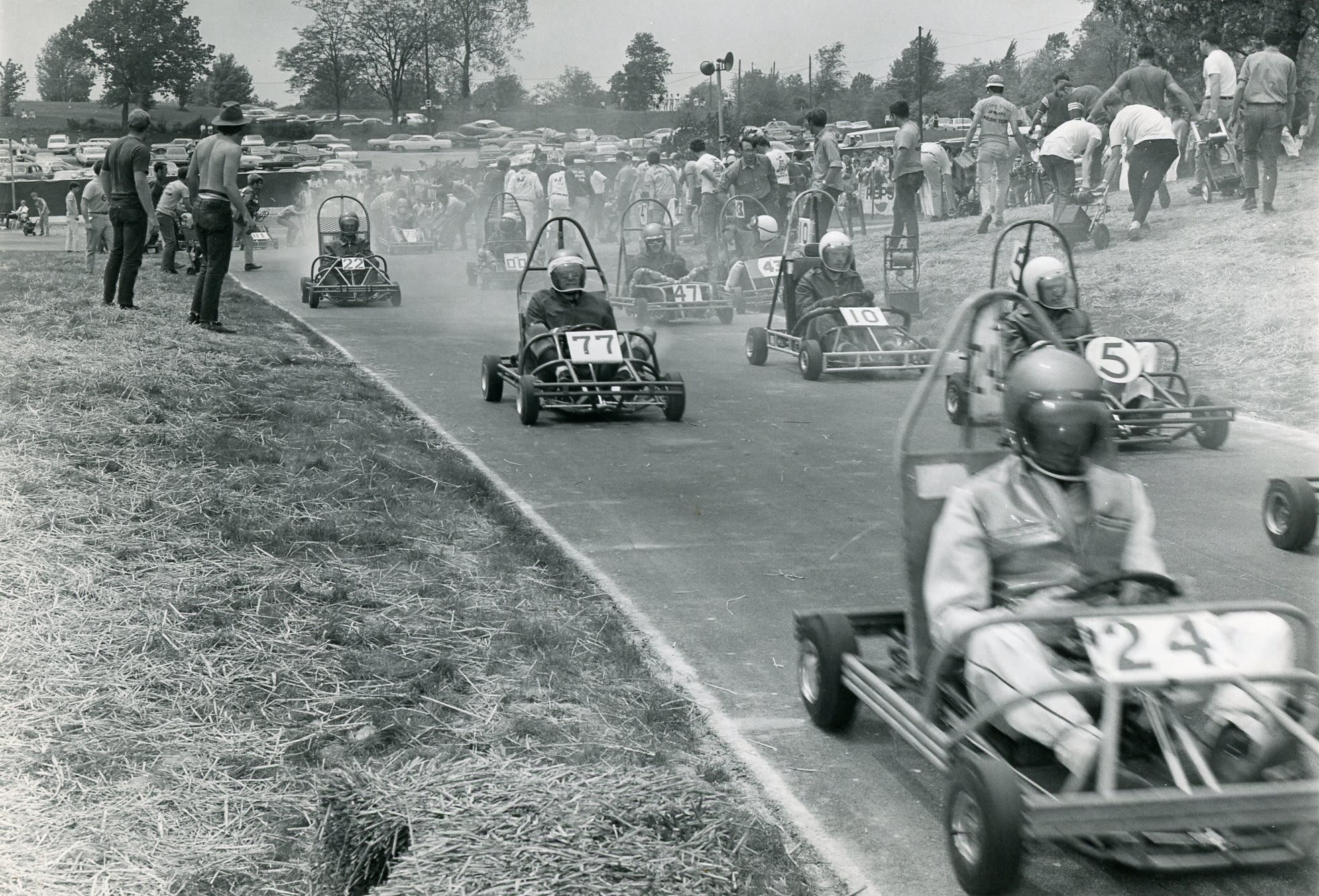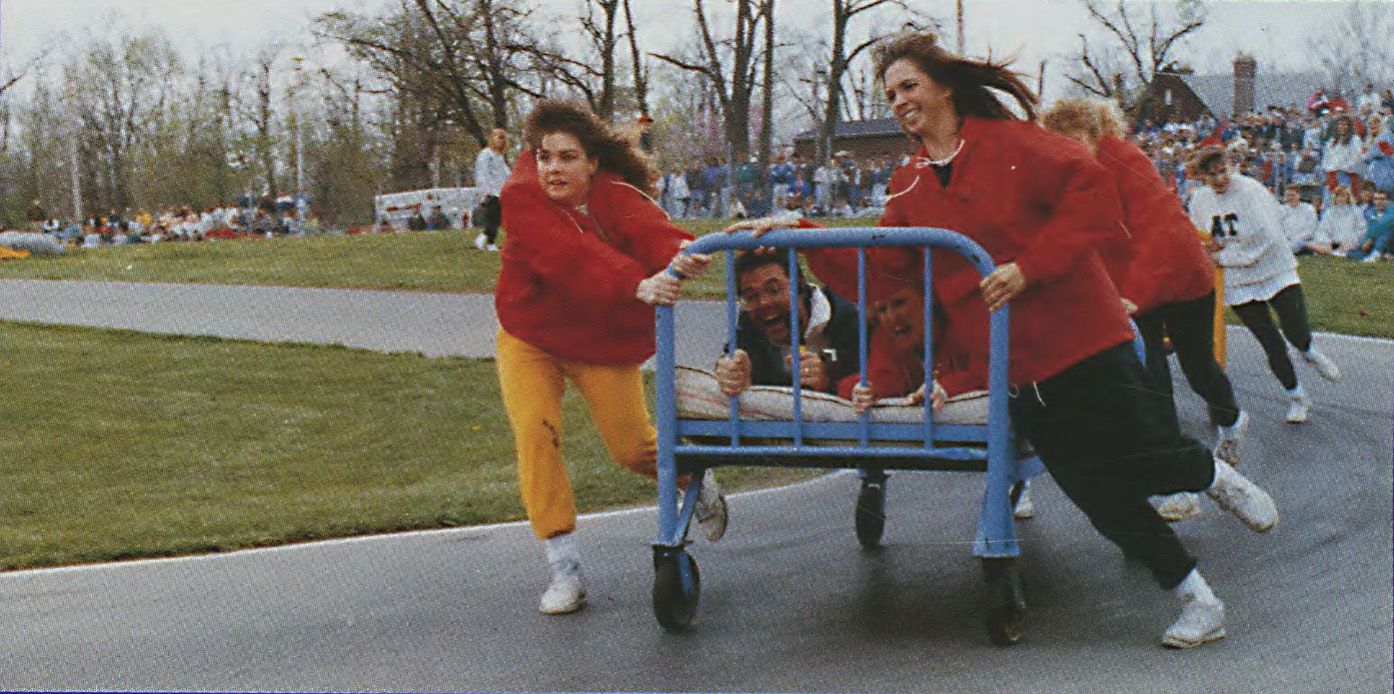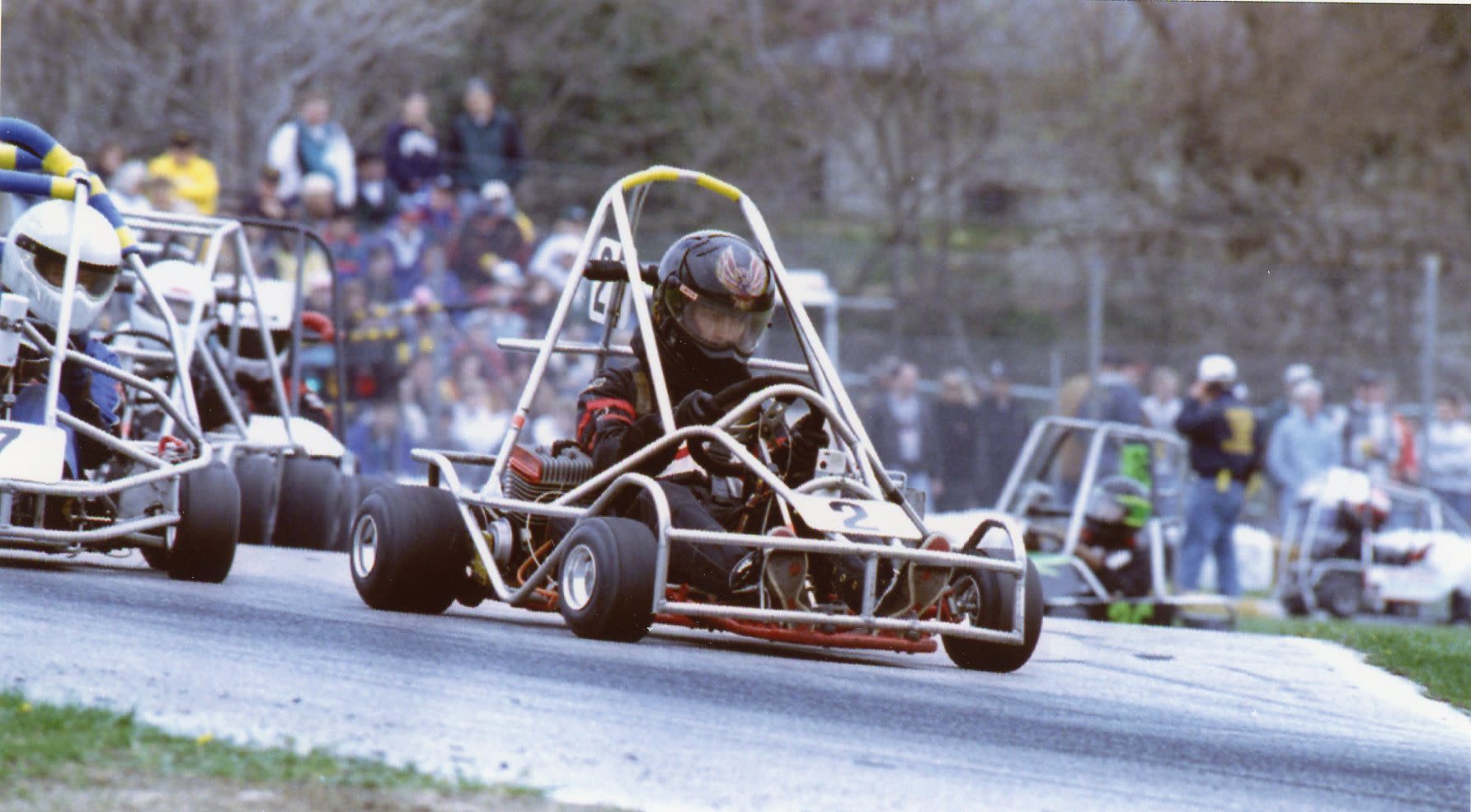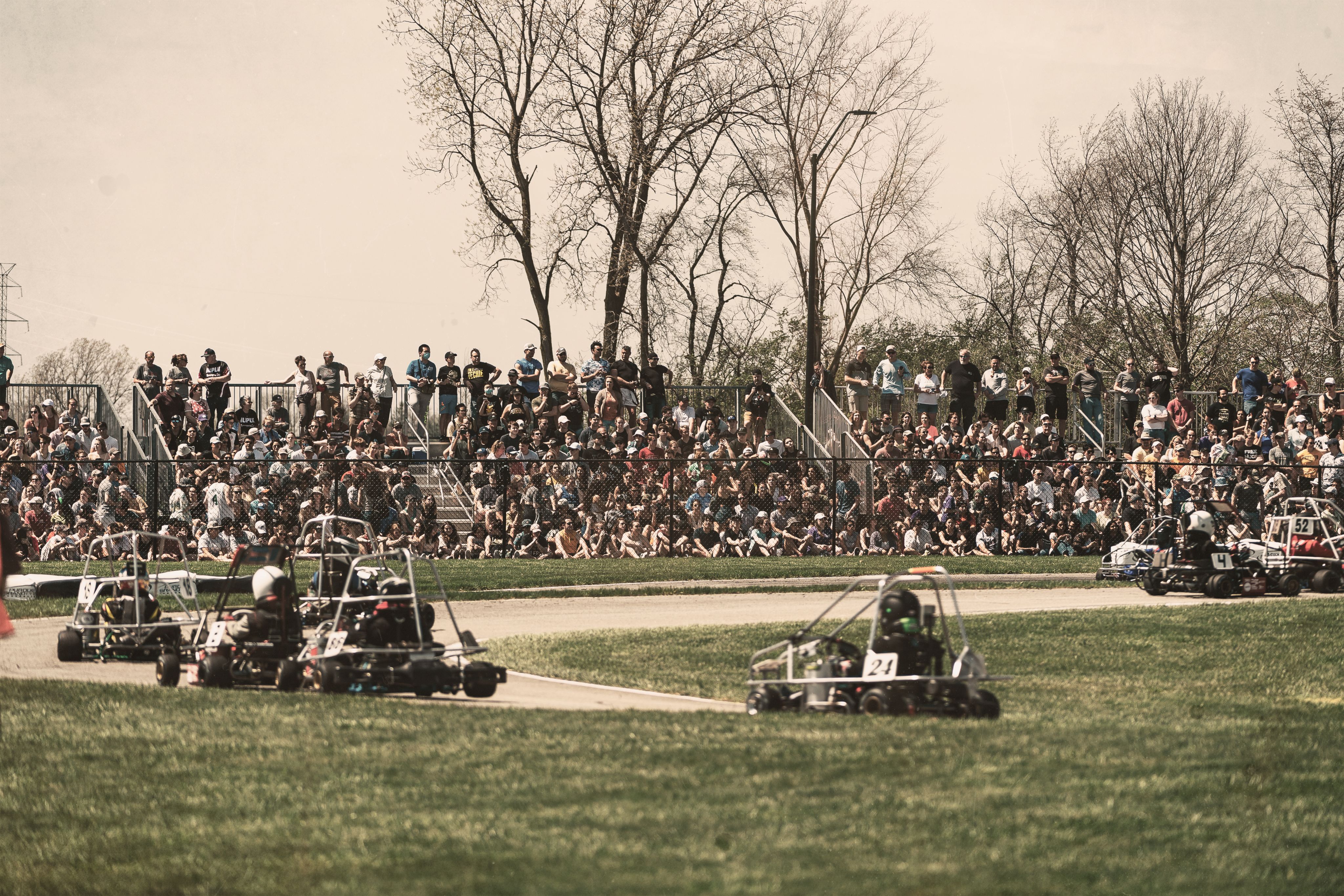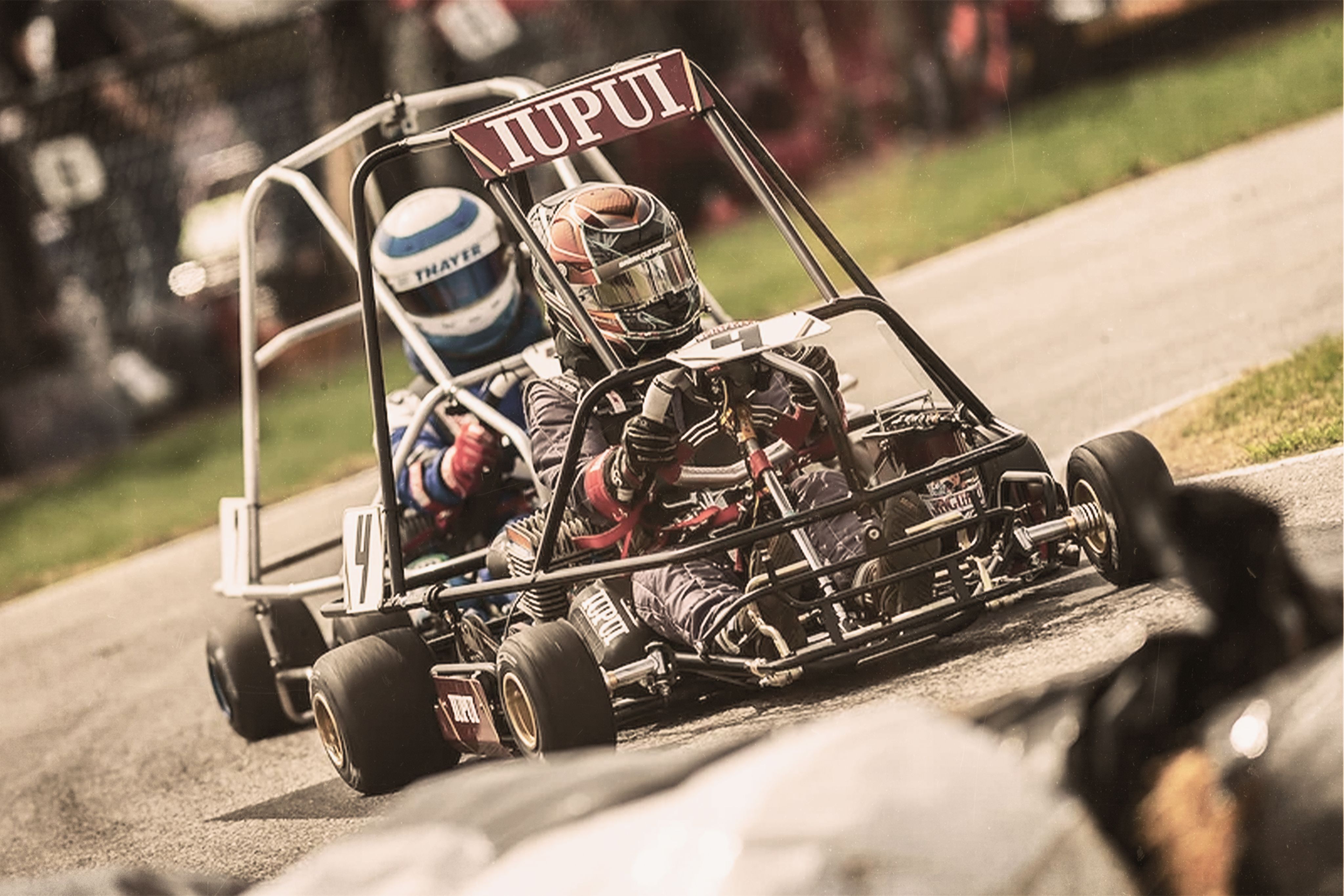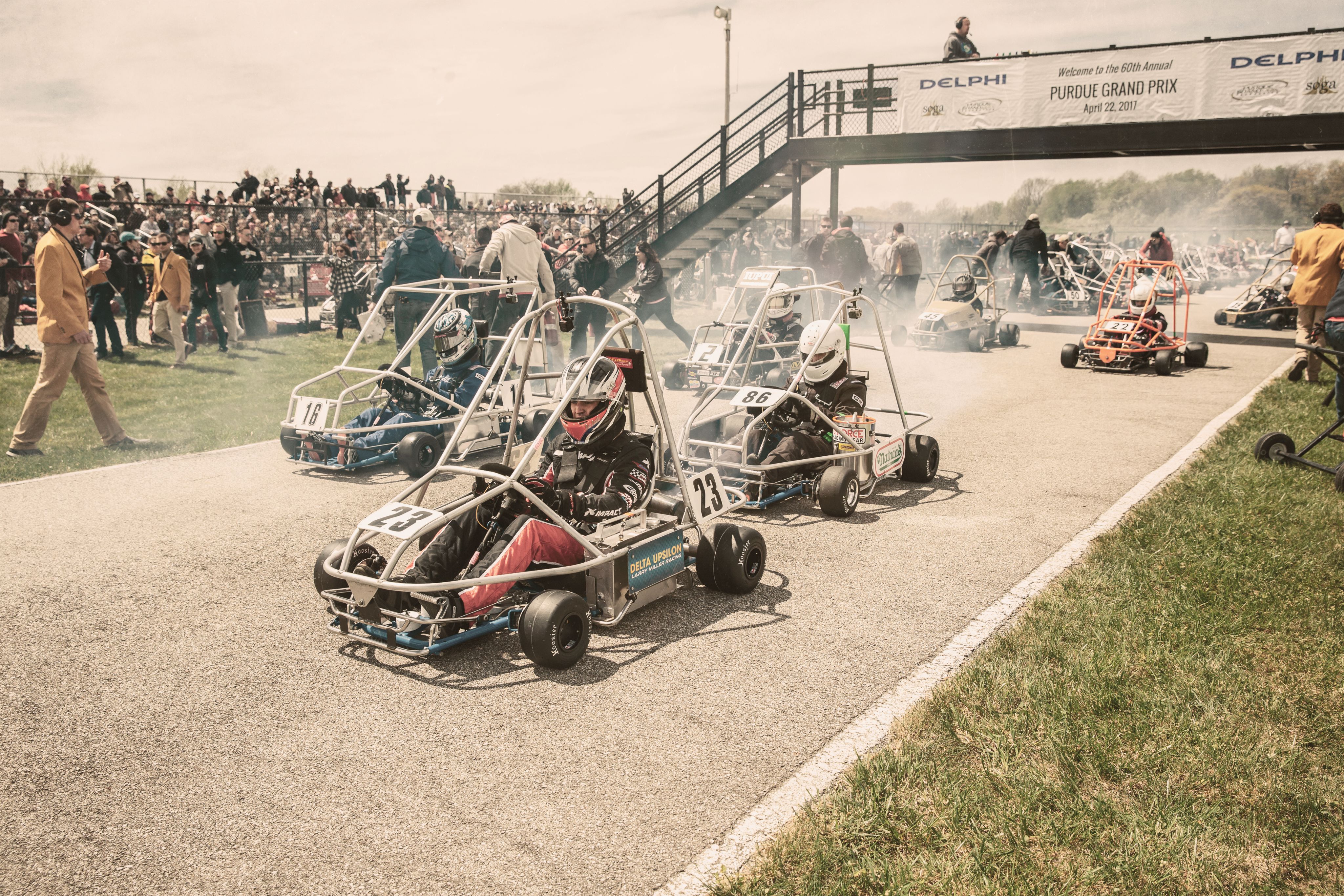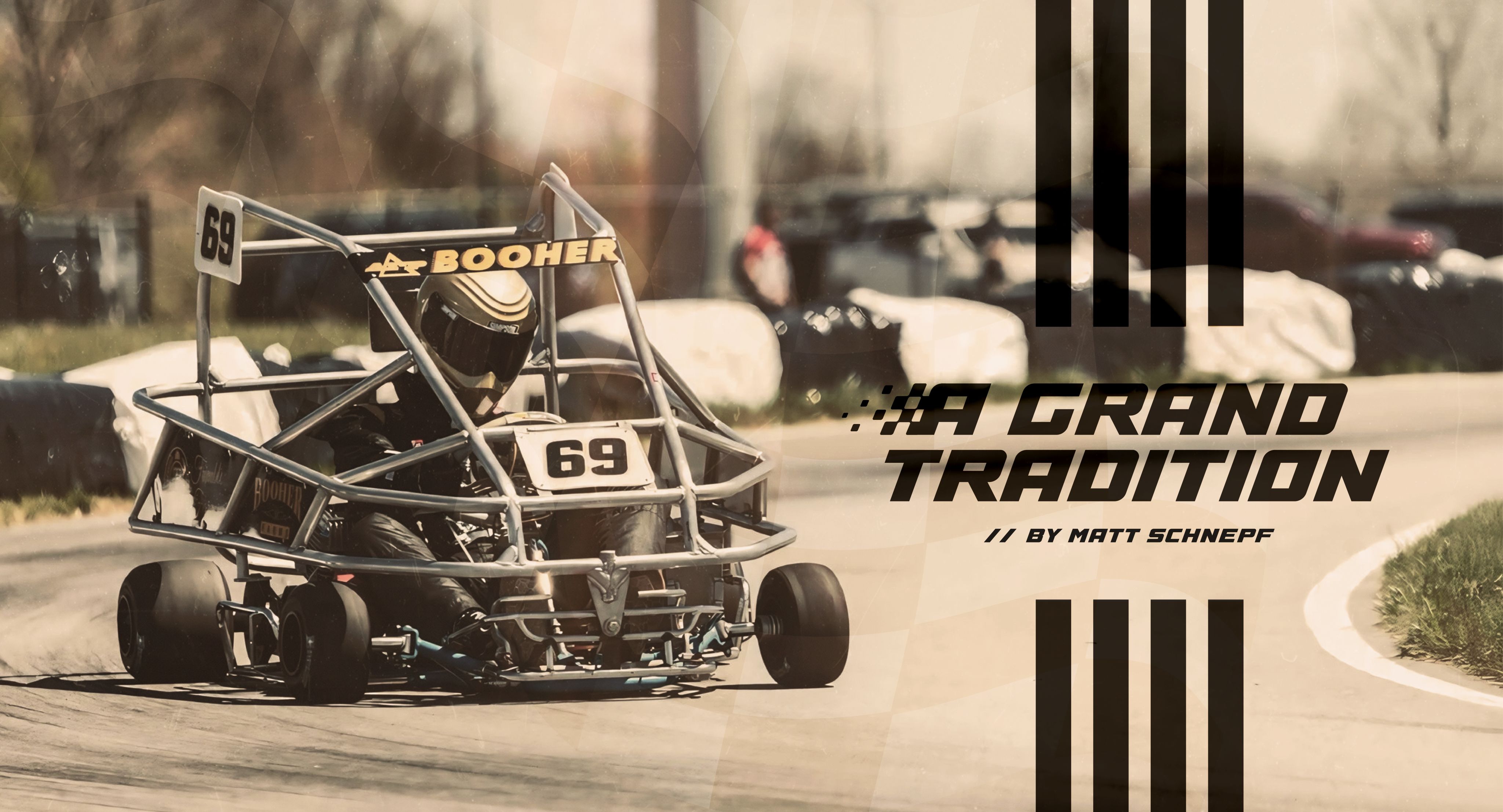
Just an hour northwest of the Indianapolis Motor Speedway—home of the legendary Indy 500—the Purdue Grand Prix captivates race fans in West Lafayette each spring.
The green flag first dropped on the university’s go-kart race in 1958. Originally sponsored by the Purdue Auto Club—and now overseen by a student-run foundation—Grand Prix raises scholarship support while providing students with an outlet to showcase their vast skills and knowledge.
A lineup of 33 drivers competes in the 160-lap, 50-mile race, which debuted near the present-day location of the France A. Córdova Recreational Sports Center. Today, Grand Prix takes place at the corner of McCormick Road and Cherry Lane.
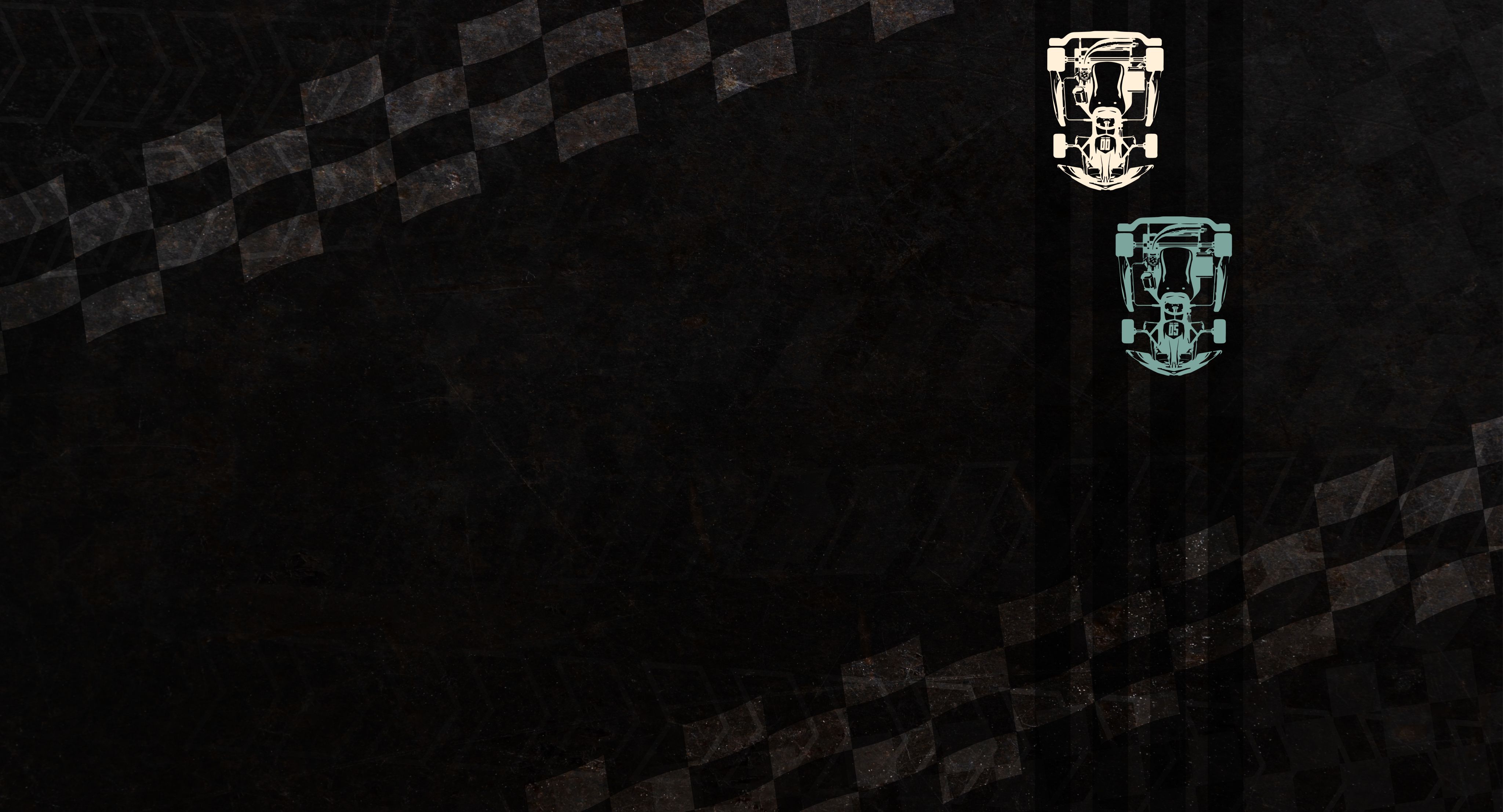

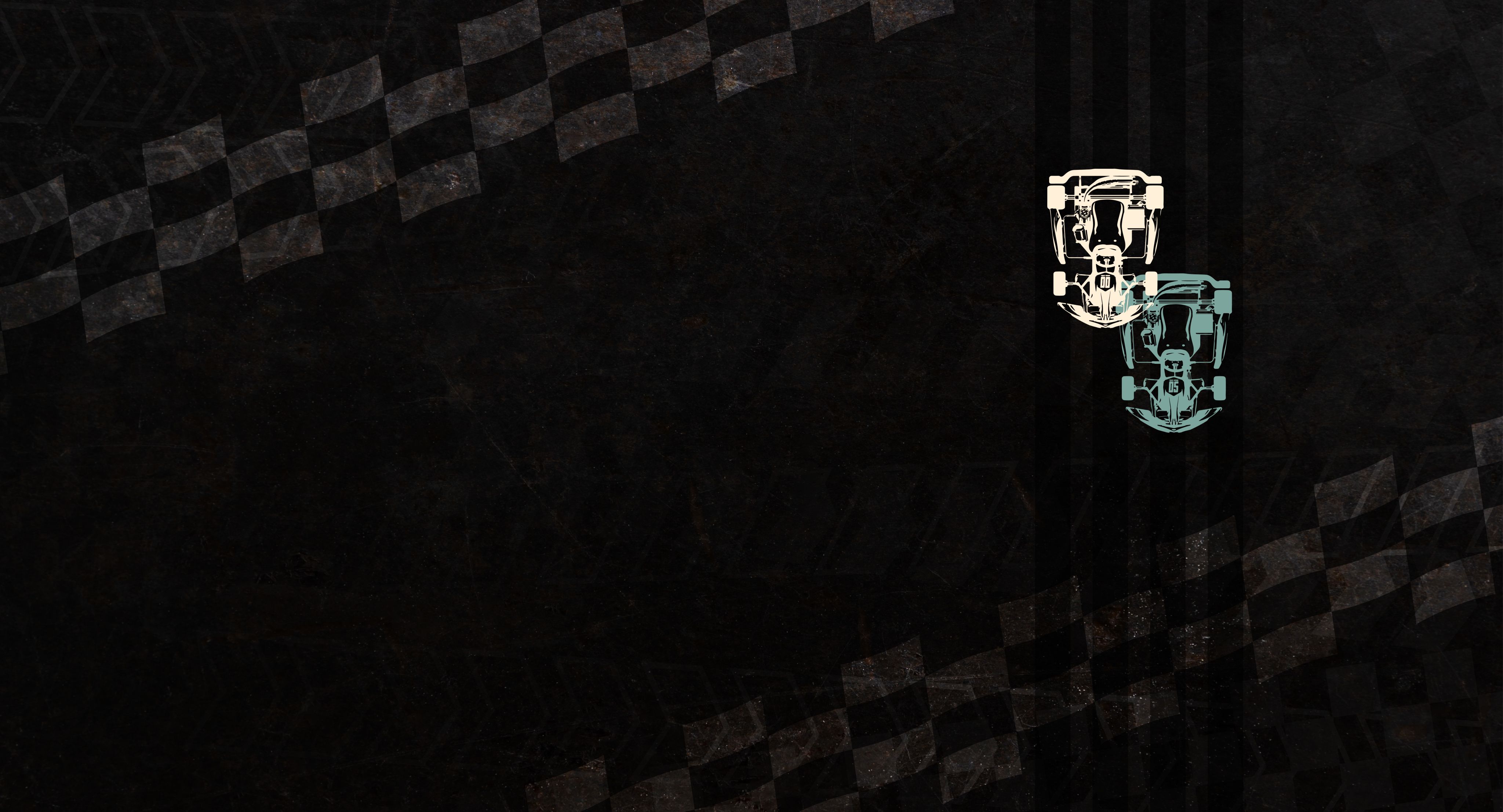
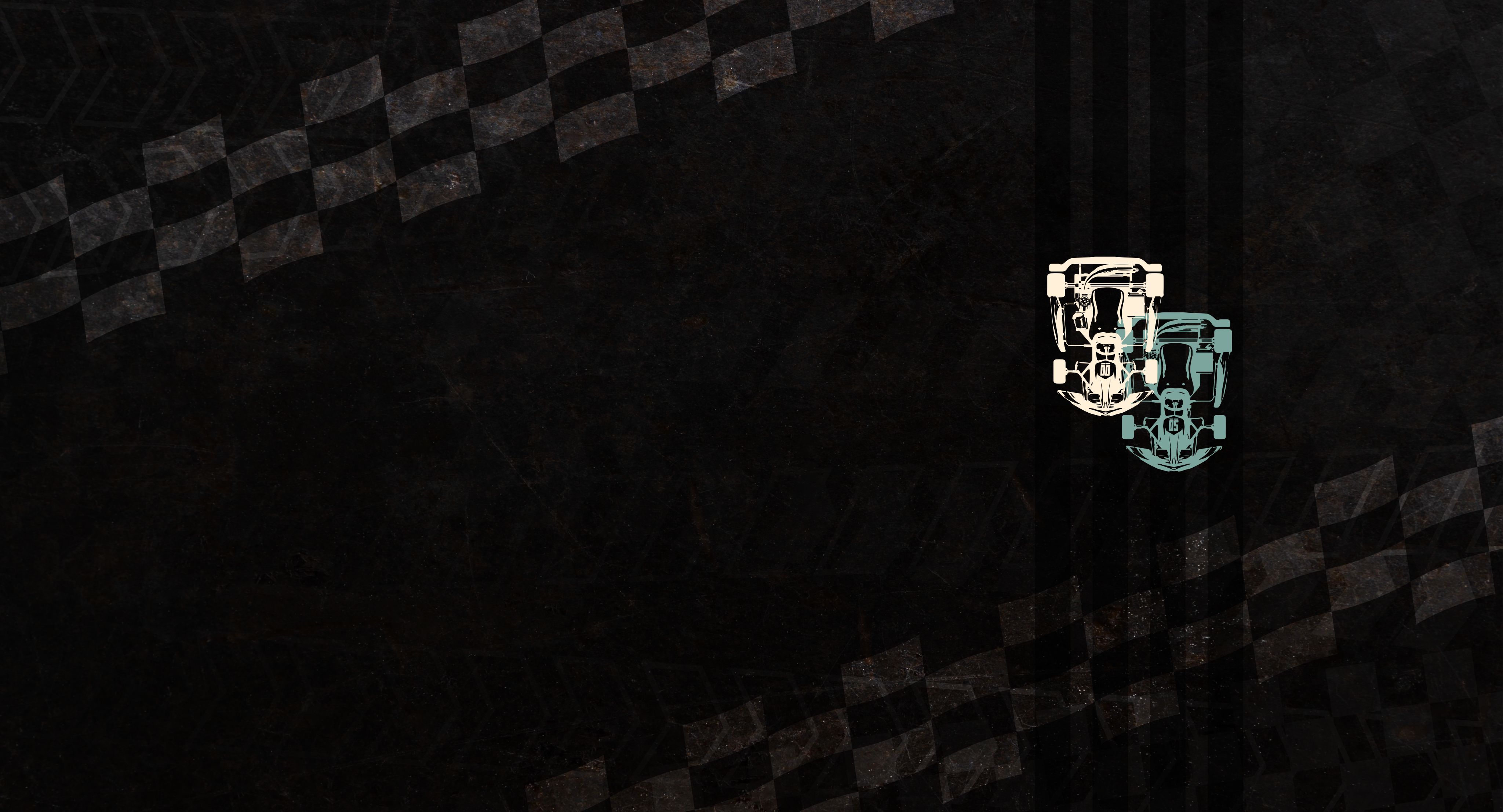
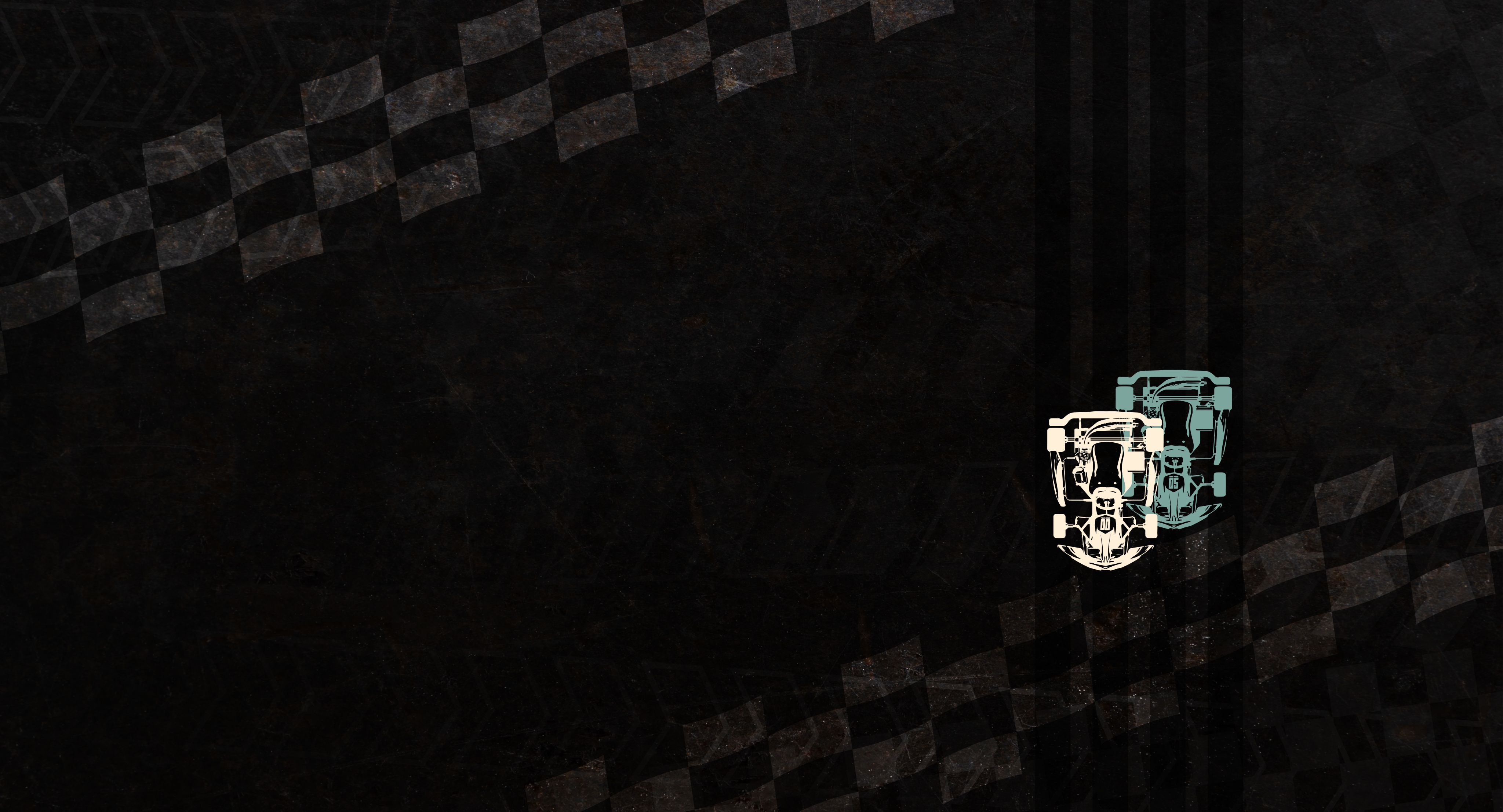

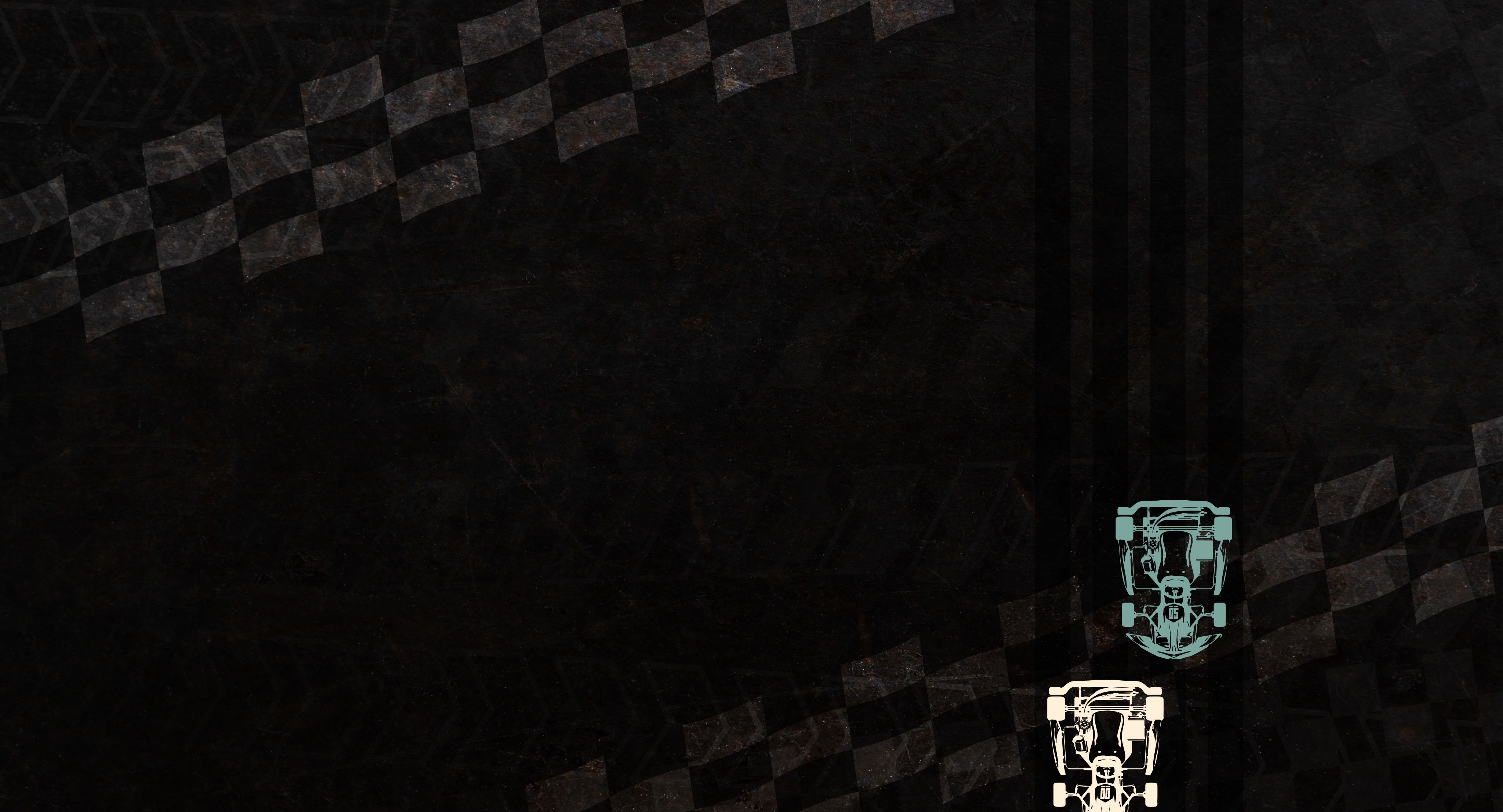
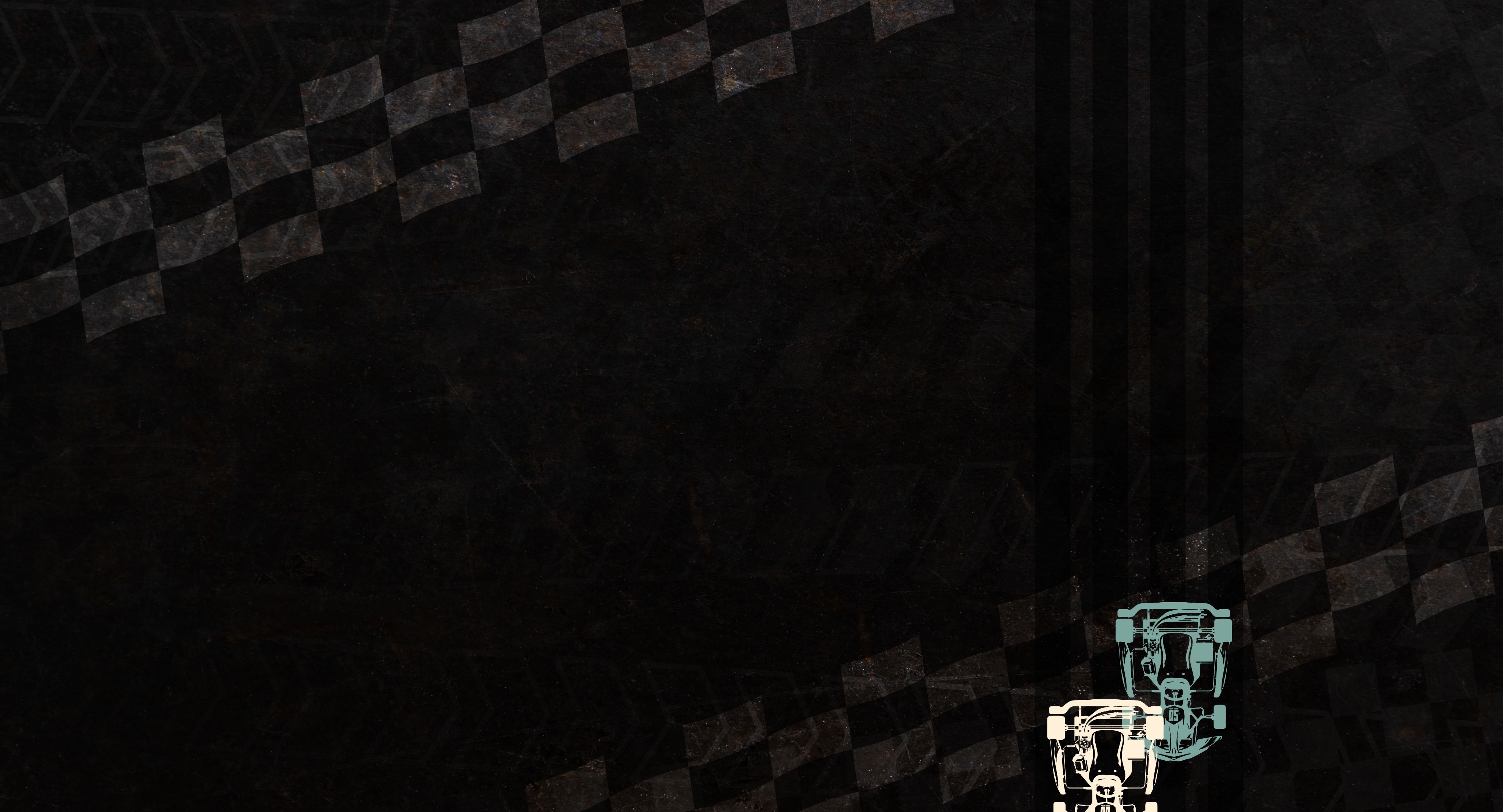
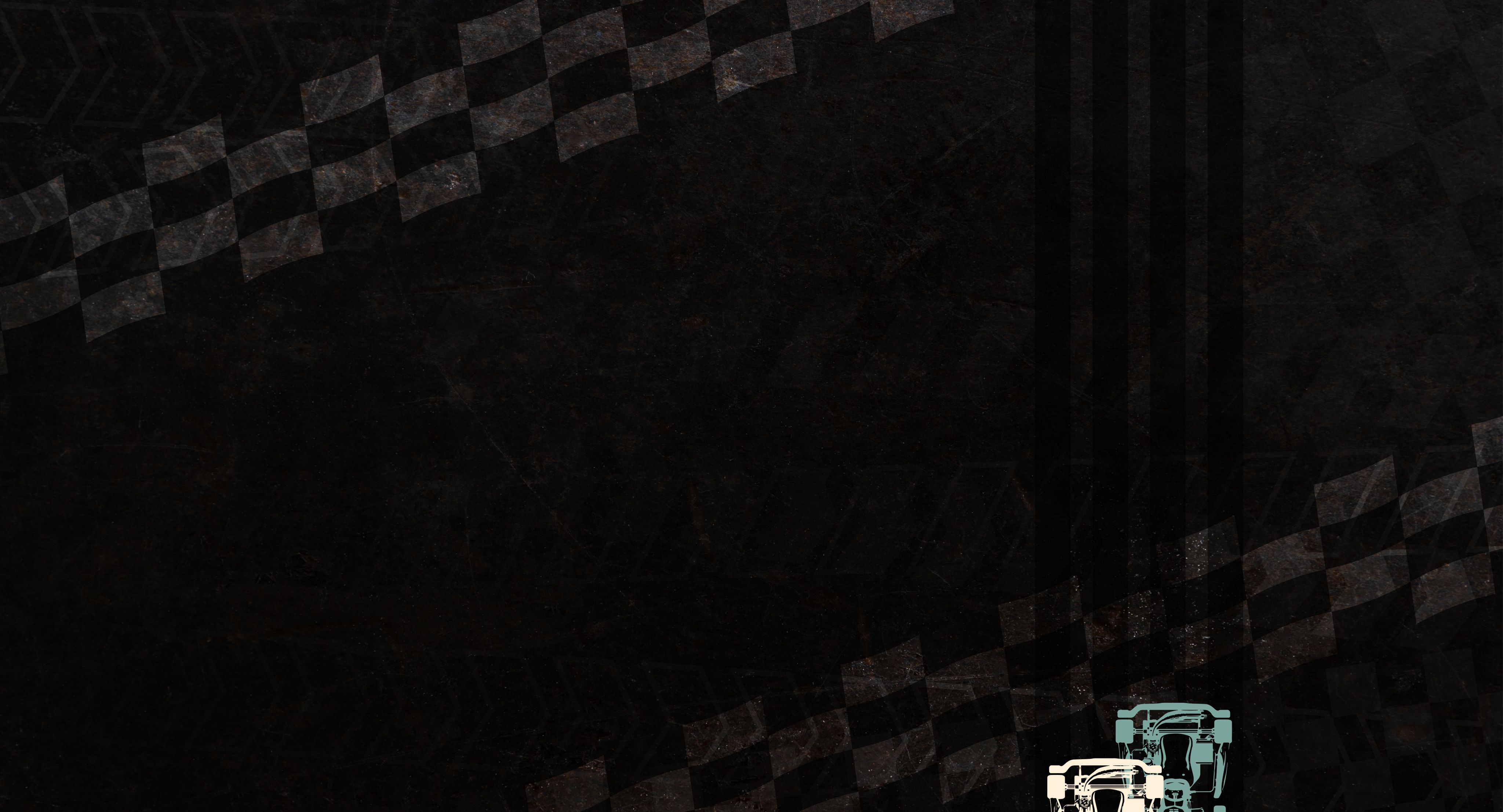
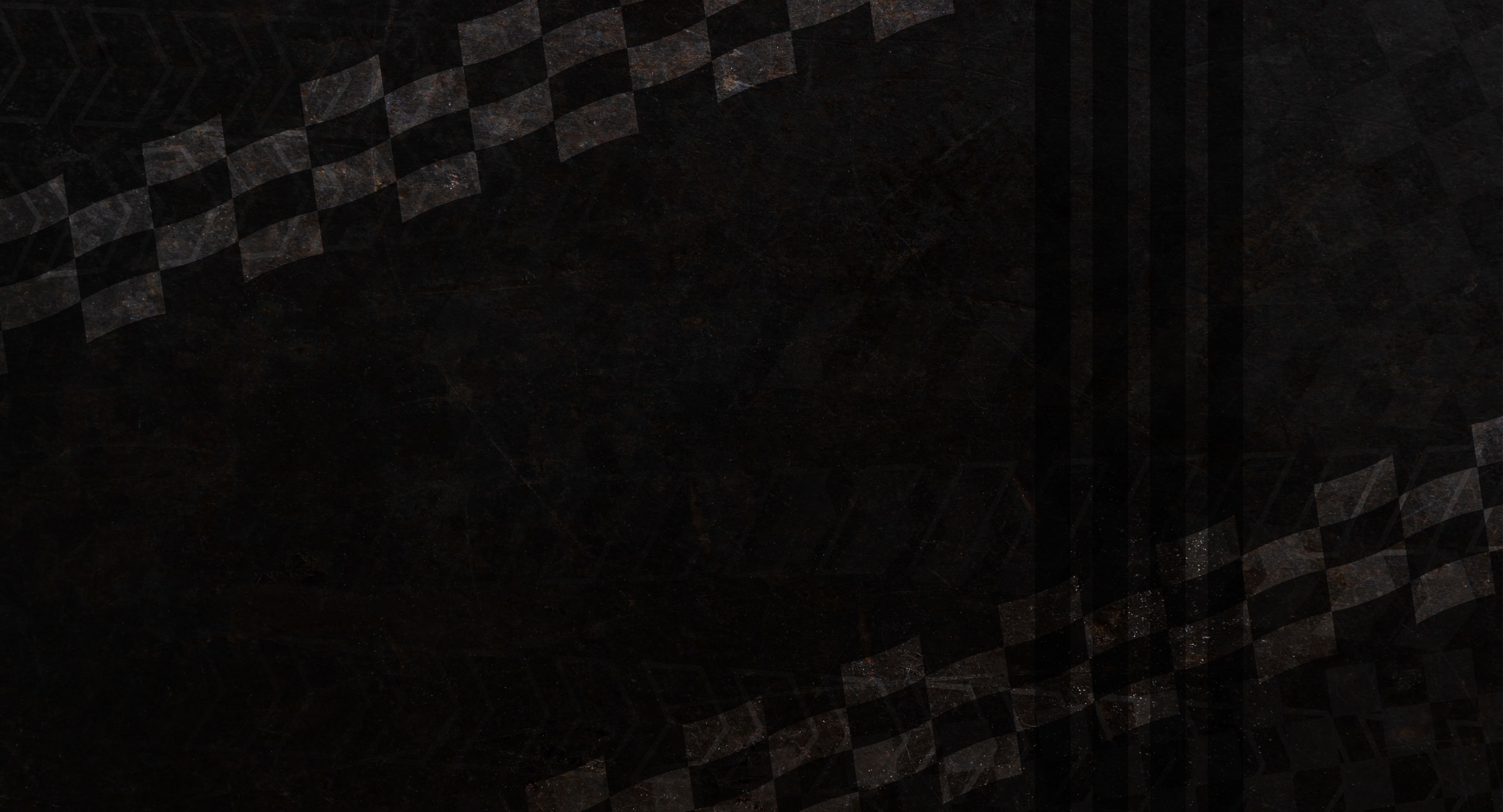
Just an hour northwest of the Indianapolis Motor Speedway—home of the legendary Indy 500—the Purdue Grand Prix captivates race fans in West Lafayette each spring.
The green flag first dropped on the university’s go-kart race in 1958. Originally sponsored by the Purdue Auto Club—and now overseen by a student-run foundation—Grand Prix raises scholarship support while providing students with an outlet to showcase their vast skills and knowledge.
A lineup of 33 drivers competes in the 160-lap, 50-mile race, which debuted near the present-day location of the France A. Córdova Recreational Sports Center. Today, Grand Prix takes place at the corner of McCormick Road and Cherry Lane.

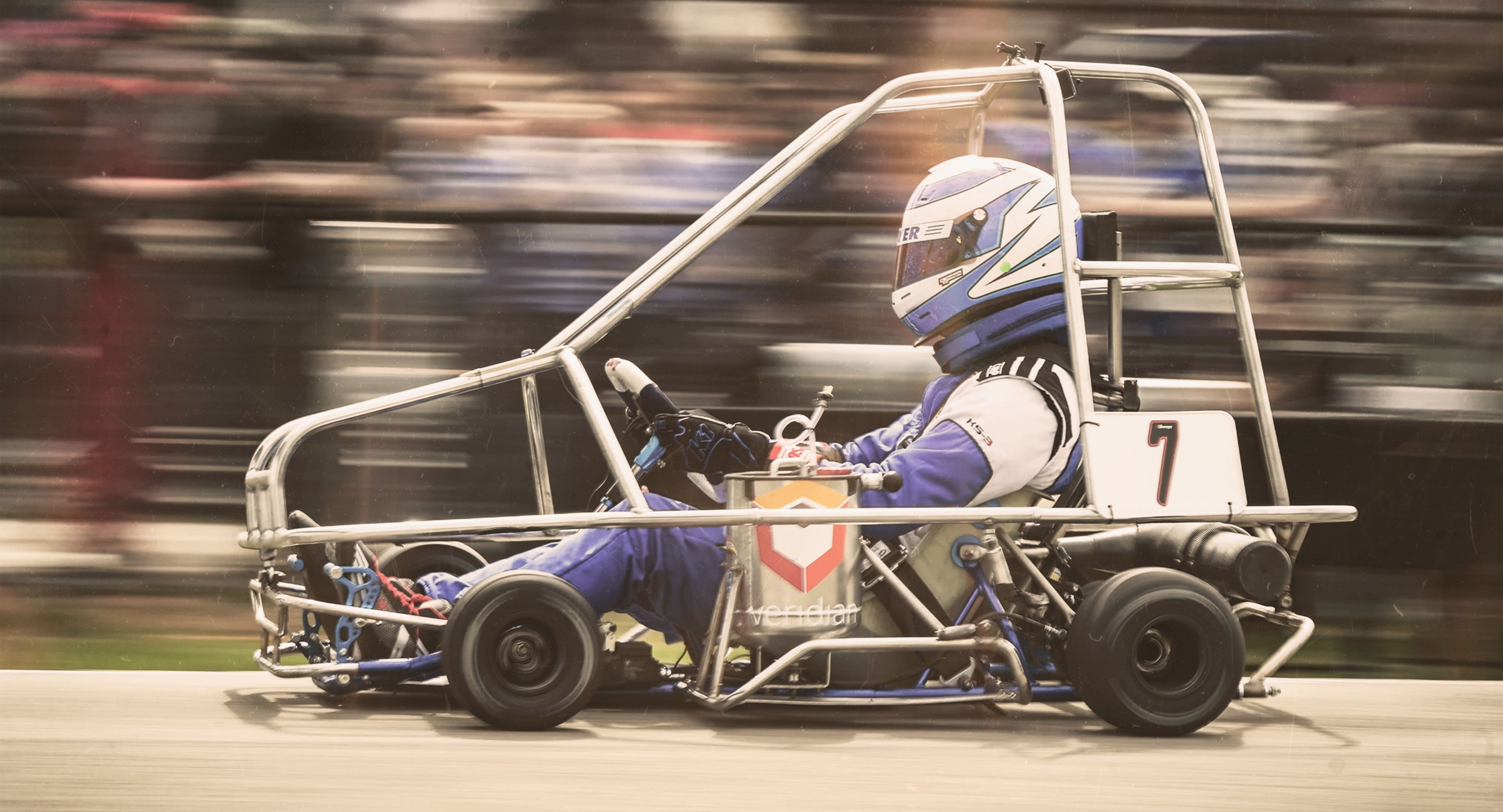
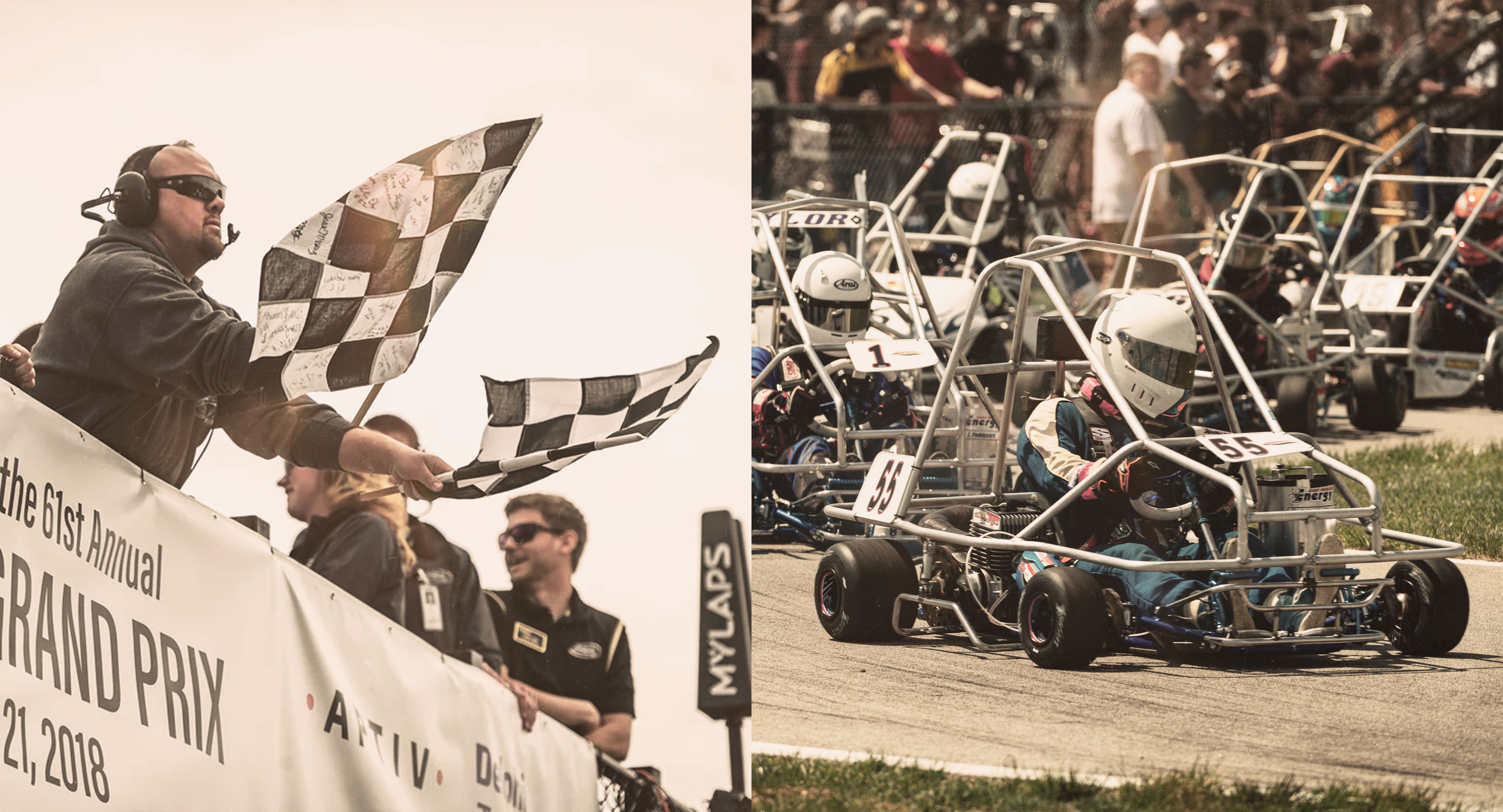
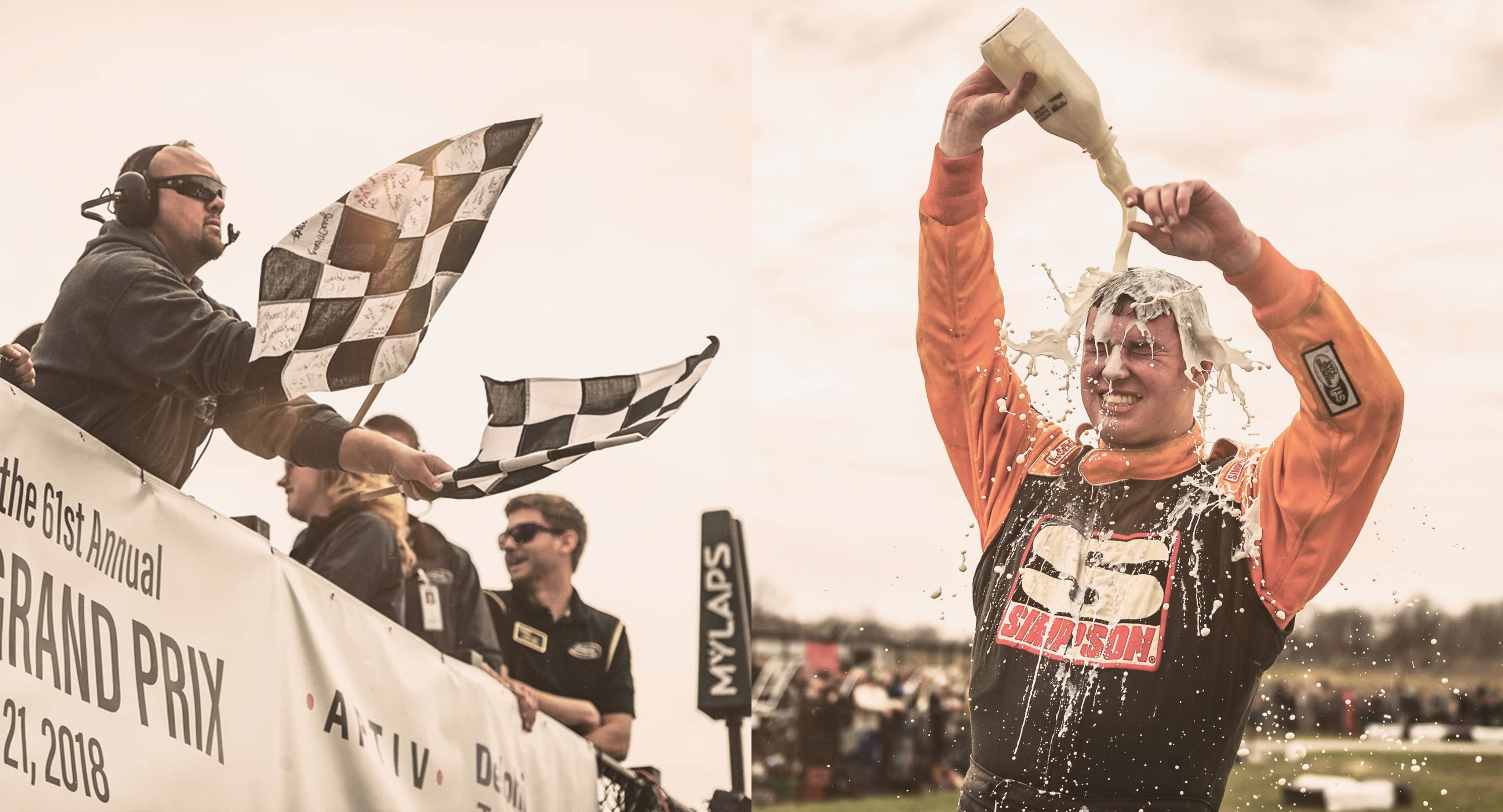
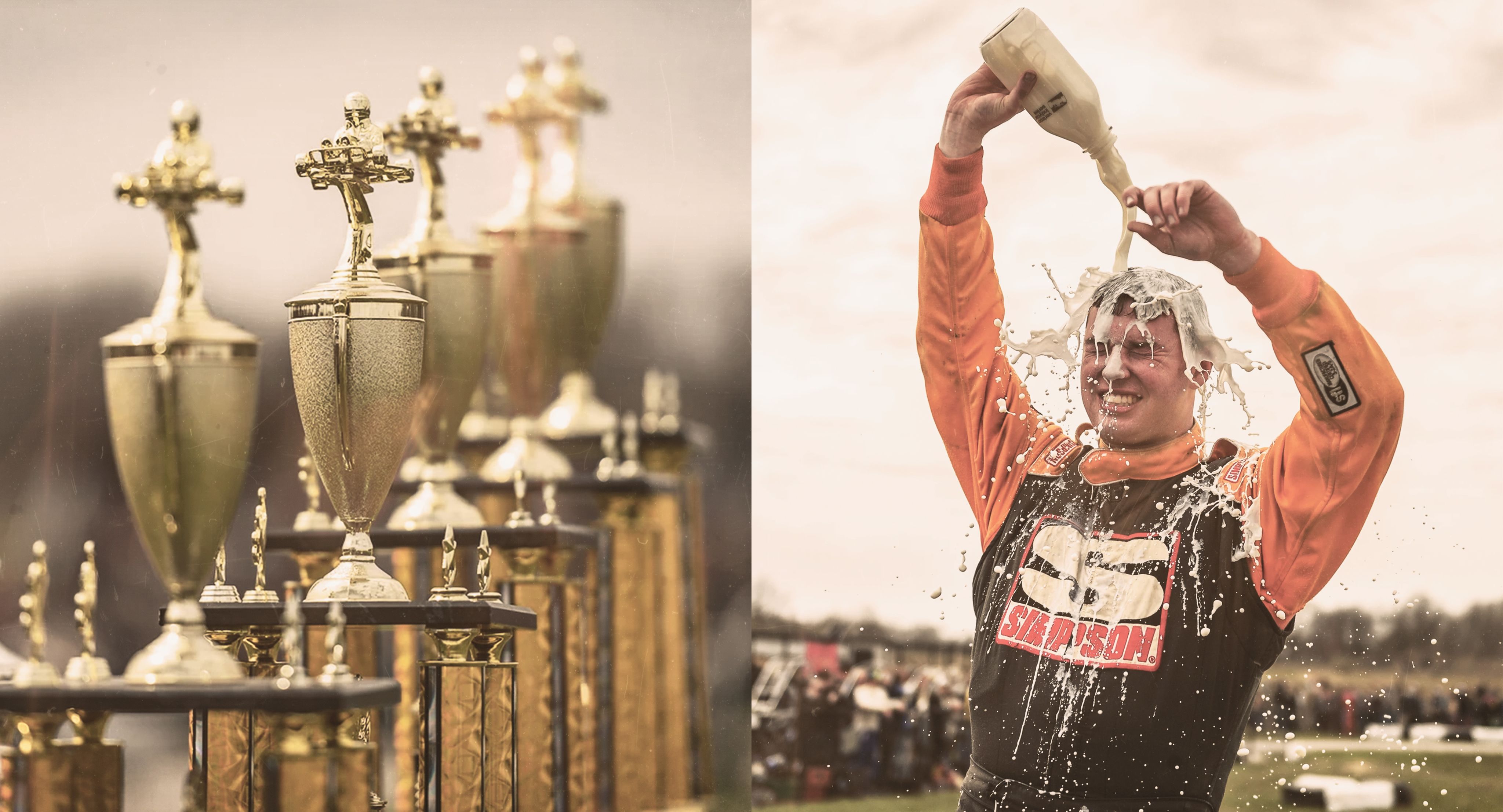
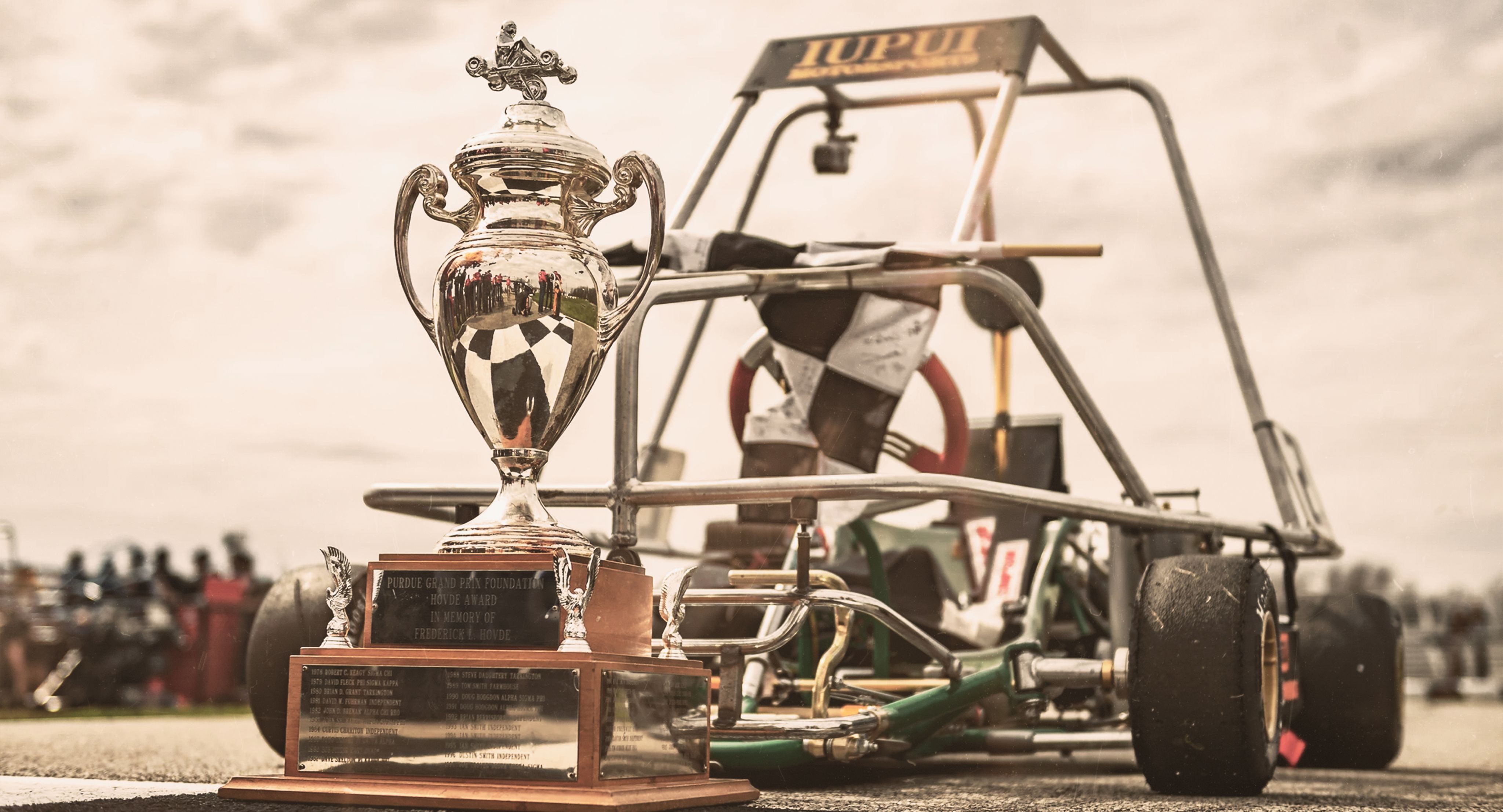
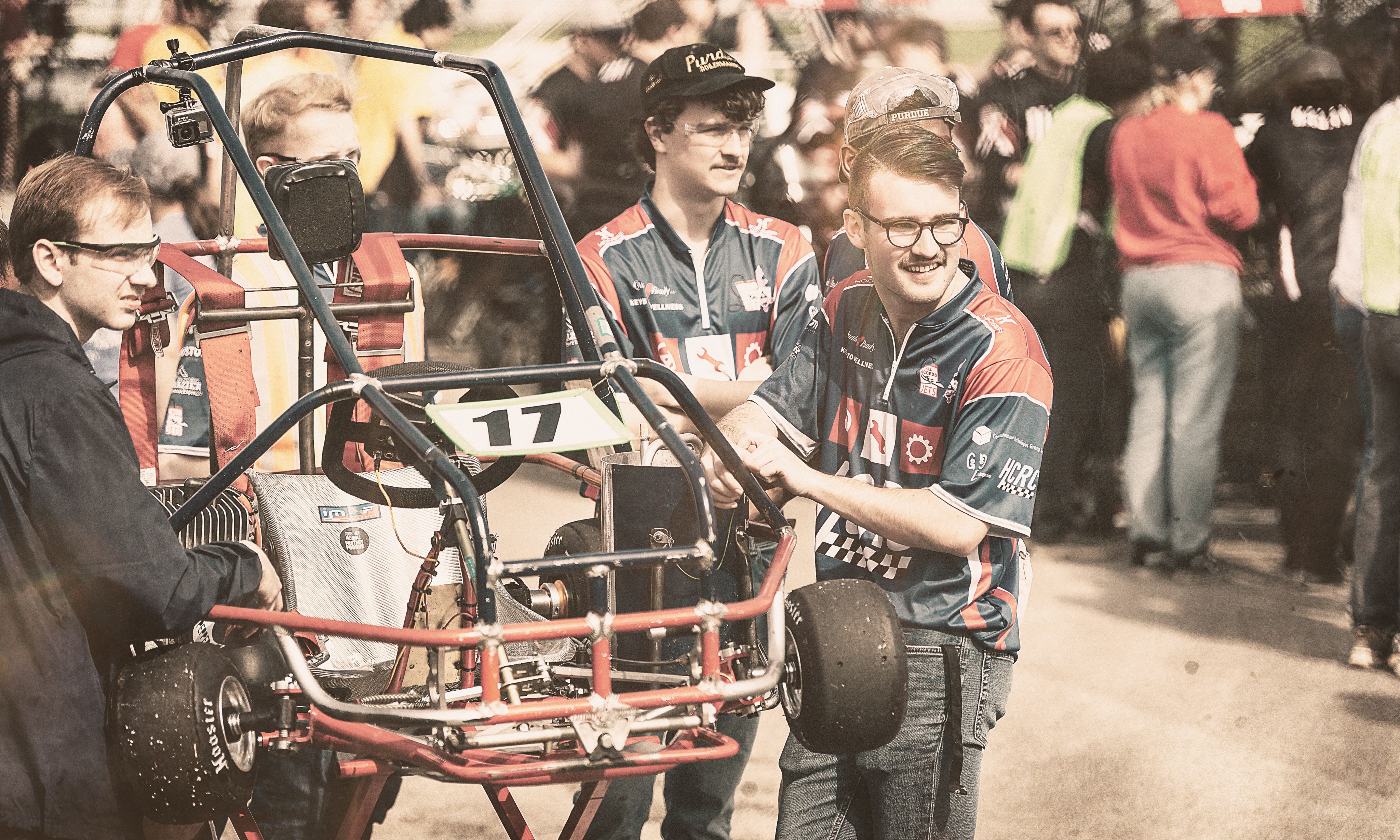
Like other Grand Prix drivers, a passion for speed fuels the racing dreams of sophomore Joe Booher, who competed in the April 2024 race.
A farm-management major, he followed in the tread marks of his father, Anthony “AJ” Booher (A’95), and maternal grandfather, Ben Hunter (A’68)—both of whom also drove in what has been hailed as “The Greatest Spectacle in College Racing.”
Ben competed in the race twice as an individual entry, in 1967 and ’68, with private backing from Sigma Phi Epsilon fraternity.
“I got involved with go-karts at a young age by racing in the summer on weekends,” he says. “For me, Grand Prix was a natural extension of that experience.”
The 1968 race proved particularly memorable for Ben. With just 20 laps to go, his go-kart suffered a flat tire, but he lacked a spare wheel. That’s when another driver whose engine had quit approached Ben with a wheel in hand, allowing him to run the final 10 laps. “His doing this for me personified the true Boilermaker spirit,” says Ben, who enjoys seeing his family’s legacy at Purdue continue.
Top image: Ben Hunter, circled, with members of the Alpha Zeta agricultural honorary fraternity.
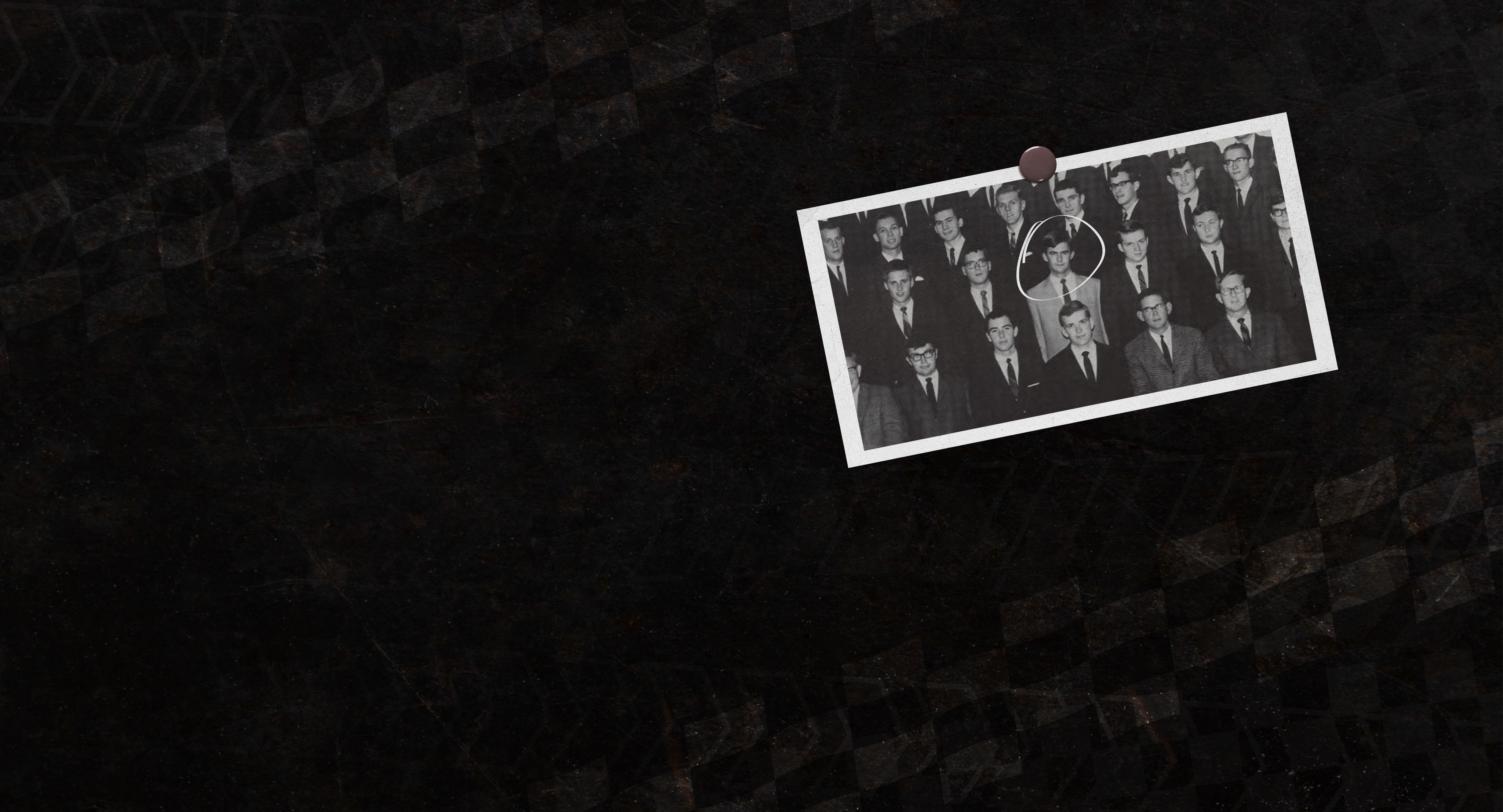
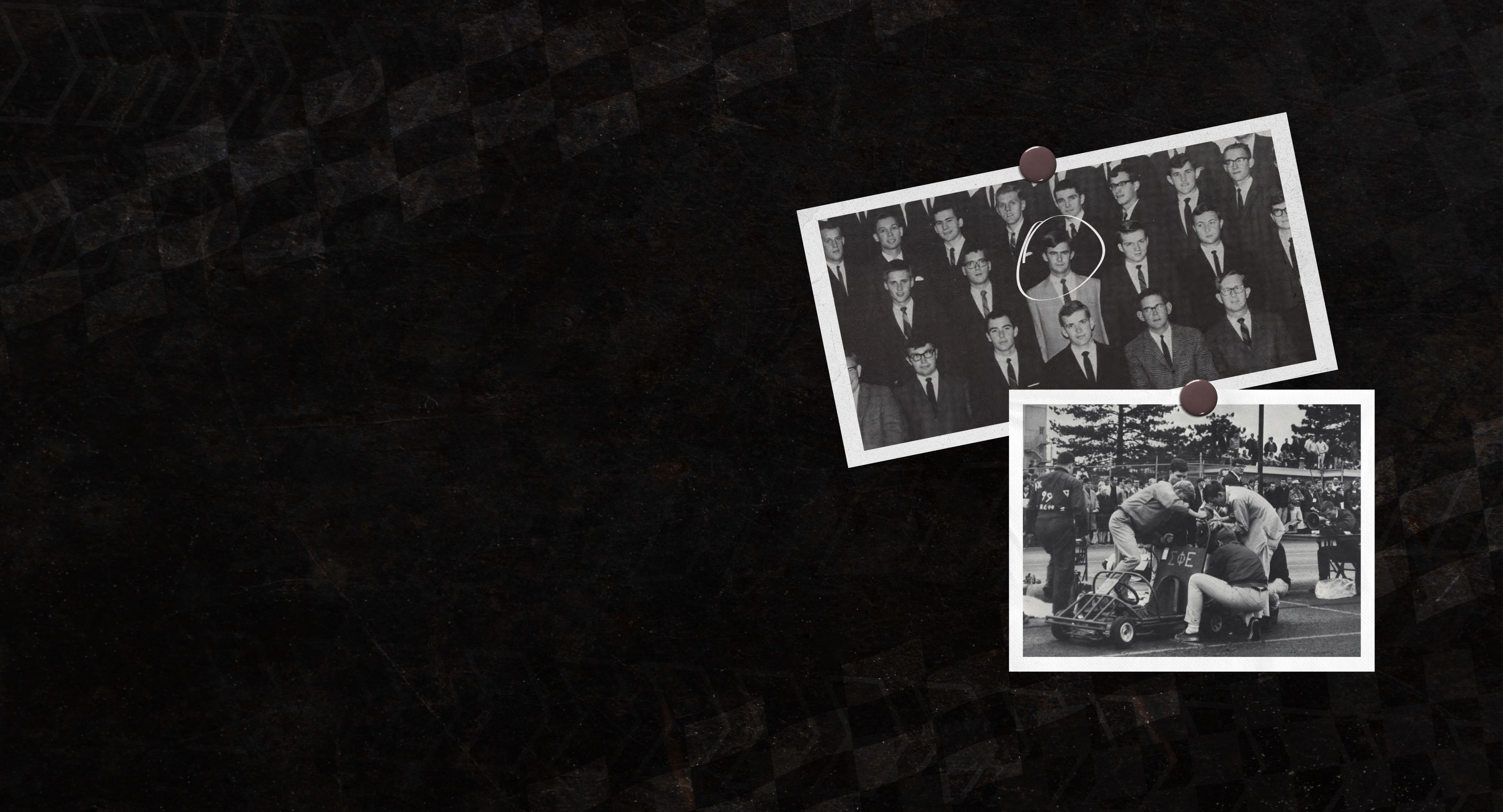
A Family Affair
Like other Grand Prix drivers, a passion for speed fuels the racing dreams of sophomore Joe Booher, who competed in the April 2024 race.
A farm-management major, he followed in the tread marks of his father, Anthony “AJ” Booher (A’95), and maternal grandfather, Ben Hunter (A’68)—both of whom also drove in what has been hailed as “The Greatest Spectacle in College Racing.”
Ben competed in the race twice as an individual entry, in 1967 and ’68, with private backing from Sigma Phi Epsilon fraternity.
“I got involved with go-karts at a young age by racing in the summer on weekends,” he says. “For me, Grand Prix was a natural extension of that experience.”
The 1968 race proved particularly memorable for Ben. With just 20 laps to go, his go-kart suffered a flat tire, but he lacked a spare wheel. That’s when another driver whose engine had quit approached Ben with a wheel in hand, allowing him to run the final 10 laps. “His doing this for me personified the true Boilermaker spirit,” says Ben, who enjoys seeing his family’s legacy at Purdue continue.
Top image: Ben Hunter, circled, with members of the Alpha Zeta agricultural honorary fraternity.
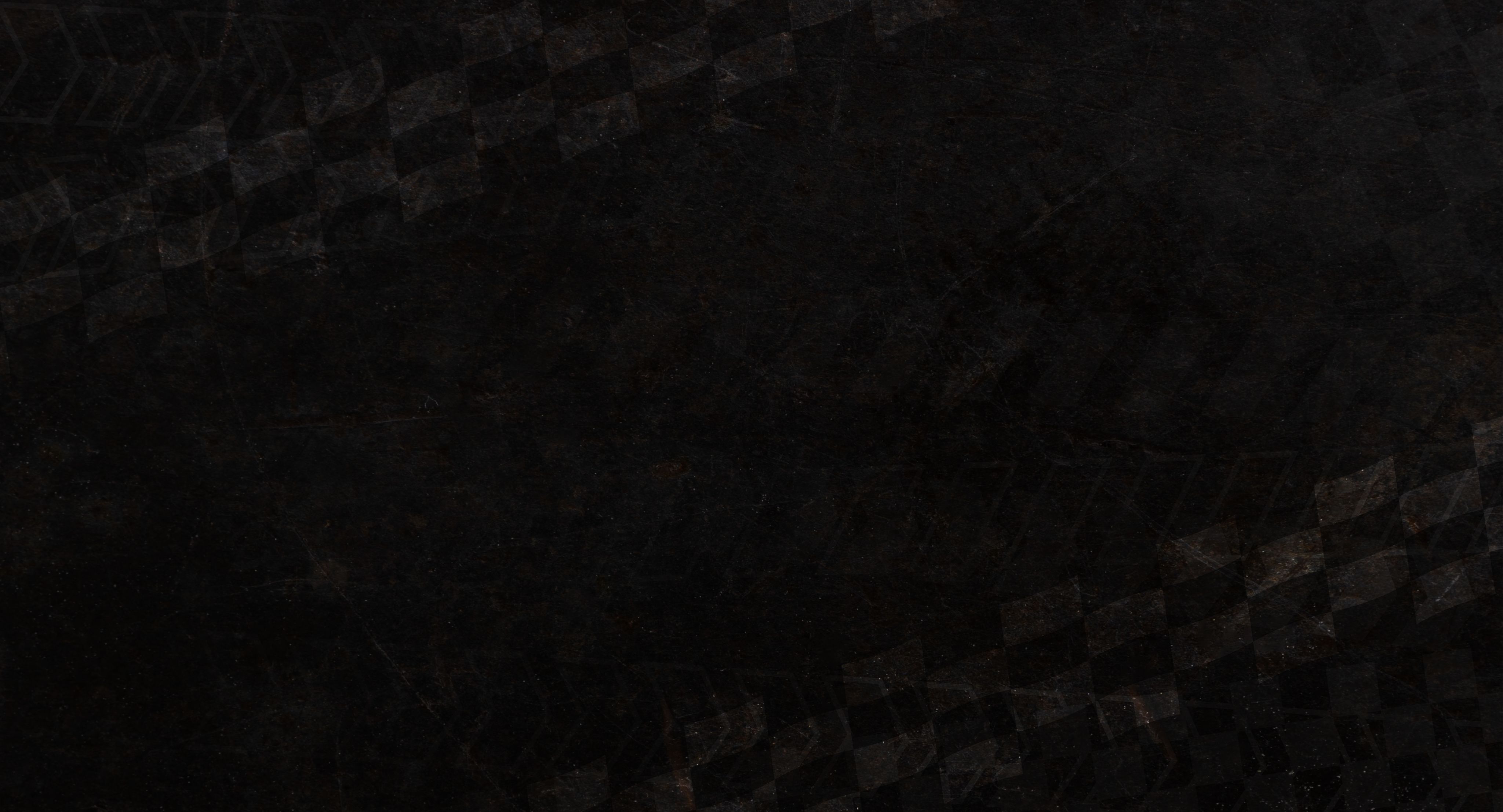
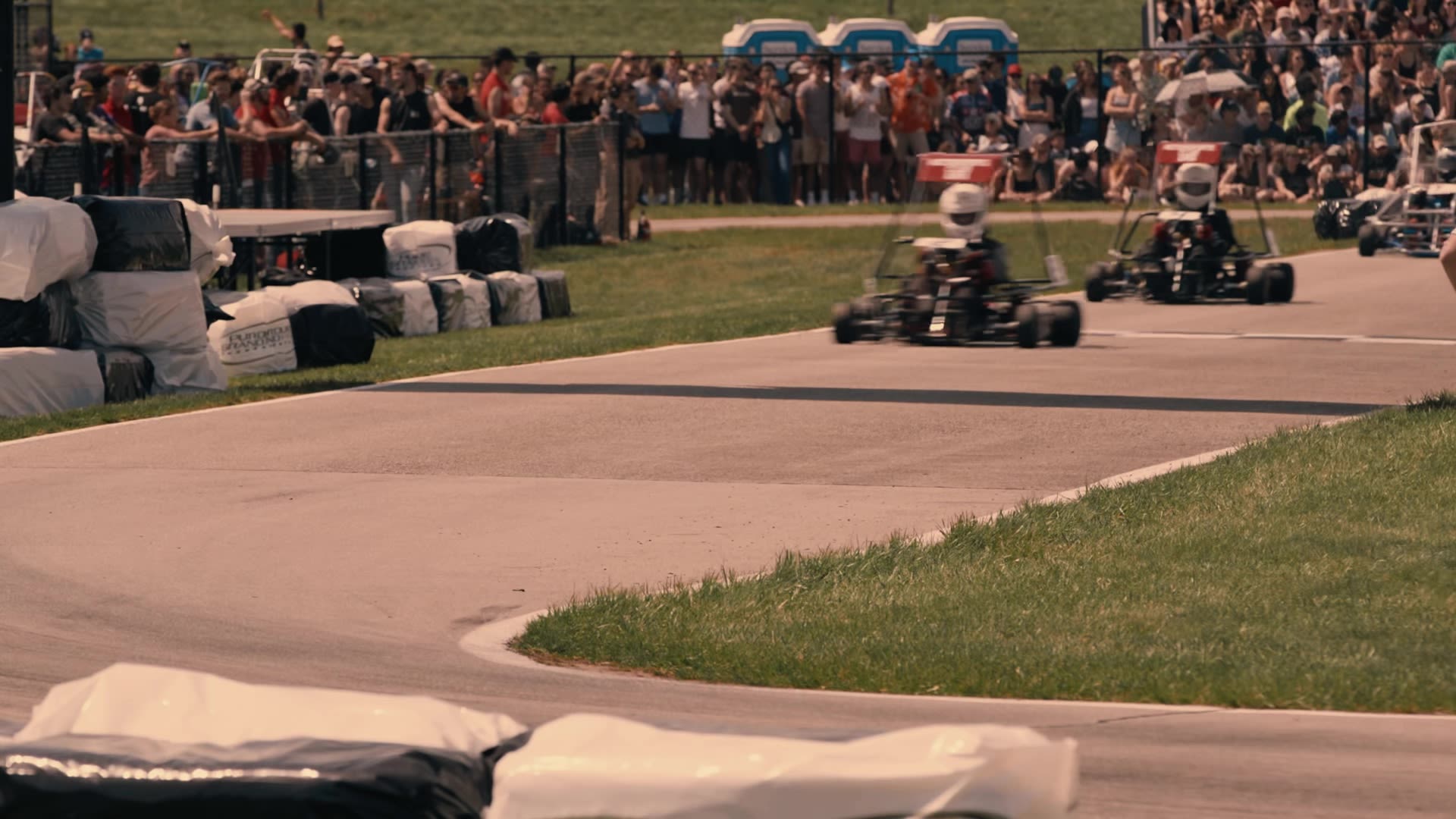

A Fatherʼs Inspiration
Ben’s son-in-law, AJ, developed an interest in racing by watching his own father, Donald Joe Booher (CERT A’60), who competed in several NASCAR Winston Cup Series races and qualified for the 1980 Daytona 500.
AJ’s name even honors his father’s favorite driver and close friend, four-time Indy 500 champion A.J. Foyt Jr.
“Dad would compete two or three times a year—never a top 10 finish—but was doing it as a hobby, happy just to make the show,” AJ says. Sadly, his father died in 1993 following a crash at Daytona International Speedway, just shy of his 52nd birthday.
AJ first raced go-karts at the age of 7, continuing for 15 years before transitioning to mini sprint and non-wing sprint cars. Driving for Alpha Gamma Rho fraternity, he competed in Grand Prix four times (1992–95).
“My dad’s passion was always about the joy of racing, not the results,” AJ says. “That’s what drove me all those years—to honor his love for the track.”
AJ initially participated in Grand Prix while still in high school. He knew some of the Alpha Gamma Rho team members, lent them his equipment, and helped them make adjustments to the go-kart.
“I then began driving for the team during my freshman year at Purdue,” AJ says. “After my senior year, I donated my equipment to the fraternity house.”
He competed in the 1997 and 2012 alumni races before hanging up his helmet, noting, “I’d raced since 1980, and now it was time for my children to get started in the sport.”
The education AJ received at Purdue, in addition to hands-on activities like Grand Prix, gave him the knowledge and drive to succeed. He and his wife, Amy, own 650 acres of land and lease an additional 3,350 acres where they raise corn, soybeans, and cattle. High school sweethearts living outside of West Lafayette, they both grew up on corn and soybean farms that have been passed down from generation to generation for more than 150 years. In addition to son Joe, they are also parents to Purdue senior Kayla and Harrison High School junior Zach.
Top image: Donald Joe Booher
Bottom image: AJ, Joe, Amy, and Kayla Booher


A Fatherʼs Inspiration
Ben’s son-in-law, AJ, developed an interest in racing by watching his own father, Donald Joe Booher (CERT A’60), who competed in several NASCAR Winston Cup Series races and qualified for the 1980 Daytona 500.
AJ’s name even honors his father’s favorite driver and close friend, four-time Indy 500 champion A.J. Foyt Jr.
“Dad would compete two or three times a year—never a top 10 finish—but was doing it as a hobby, happy just to make the show,” AJ says. Sadly, his father died in 1993 following a crash at Daytona International Speedway, just shy of his 52nd birthday.
AJ first raced go-karts at the age of 7, continuing for 15 years before transitioning to mini sprint and non-wing sprint cars. Driving for Alpha Gamma Rho fraternity, he competed in Grand Prix four times (1992–95).
“My dad’s passion was always about the joy of racing, not the results,” AJ says. “That’s what drove me all those years—to honor his love for the track.”
AJ initially participated in Grand Prix while still in high school. He knew some of the Alpha Gamma Rho team members, lent them his equipment, and helped them make adjustments to the go-kart.
“I then began driving for the team during my freshman year at Purdue,” AJ says. “After my senior year, I donated my equipment to the fraternity house.”
He competed in the 1997 and 2012 alumni races before hanging up his helmet, noting, “I’d raced since 1980, and now it was time for my children to get started in the sport.”
The education AJ received at Purdue, in addition to hands-on activities like Grand Prix, gave him the knowledge and drive to succeed. He and his wife, Amy, own 650 acres of land and lease an additional 3,350 acres where they raise corn, soybeans, and cattle. High school sweethearts living outside of West Lafayette, they both grew up on corn and soybean farms that have been passed down from generation to generation for more than 150 years. In addition to son Joe, they are also parents to Purdue senior Kayla and Harrison High School junior Zach.
Top image: Donald Joe Booher
Bottom image: AJ, Joe, Amy, and Kayla Booher

The Next Chapter
A 2023 Harrison High graduate, Joe finished ninth in his Grand Prix debut after qualifying 25th, drawing on experience he first acquired at a young age while watching his father compete.
“I enjoyed being around the pits and cars and seeing the action up close,” he says.
Joe’s personal road to the Grand Prix began in third grade when he started driving go-karts. Soon after, he switched gears to racing dirt bikes cross country.
“I love dirt bikes, which require a lot of physical strength and endurance,” says Joe, who enjoys riding with his younger brother, Zach. “Because go-karts sit so low to the ground, I didn’t have anywhere to ride them on our property.”
He currently races competitively through the Midwest Cross Country—or MWXC—dirt-bike series but can still maneuver a go-kart with precision.
“When I got into Purdue, my dad said, ‘We’re going to get you a new go-kart,’ and that’s exactly what he did,” Joe says.
Like AJ, he also drives for Alpha Gamma Rho, hoping to bring the fraternity even greater success by working closely with crew chief Andrew Levine, a senior studying agricultural systems management.
“I could not have done it without Andrew, who has been a crew chief since his freshman year,” Joe says. “He helps us set up the car properly for the race and taught me where I need to be on the track to run fast.”
To excel in the Grand Prix, Joe also had to adapt to driving on an asphalt course.
“We raced dirt go-karts on an oval and never had to turn right,” he says. “We also tended to race in one line with everyone more or less following each other, unless we went for a pass.”
On an asphalt track, however, drivers repeatedly turn left and right, providing several different lines a driver can take.
To build Joe’s confidence prior to last spring’s race, AJ walked the track with his son to determine where Joe needed to position his vehicle to make every turn, carry the most momentum, and reach ultimate speed.
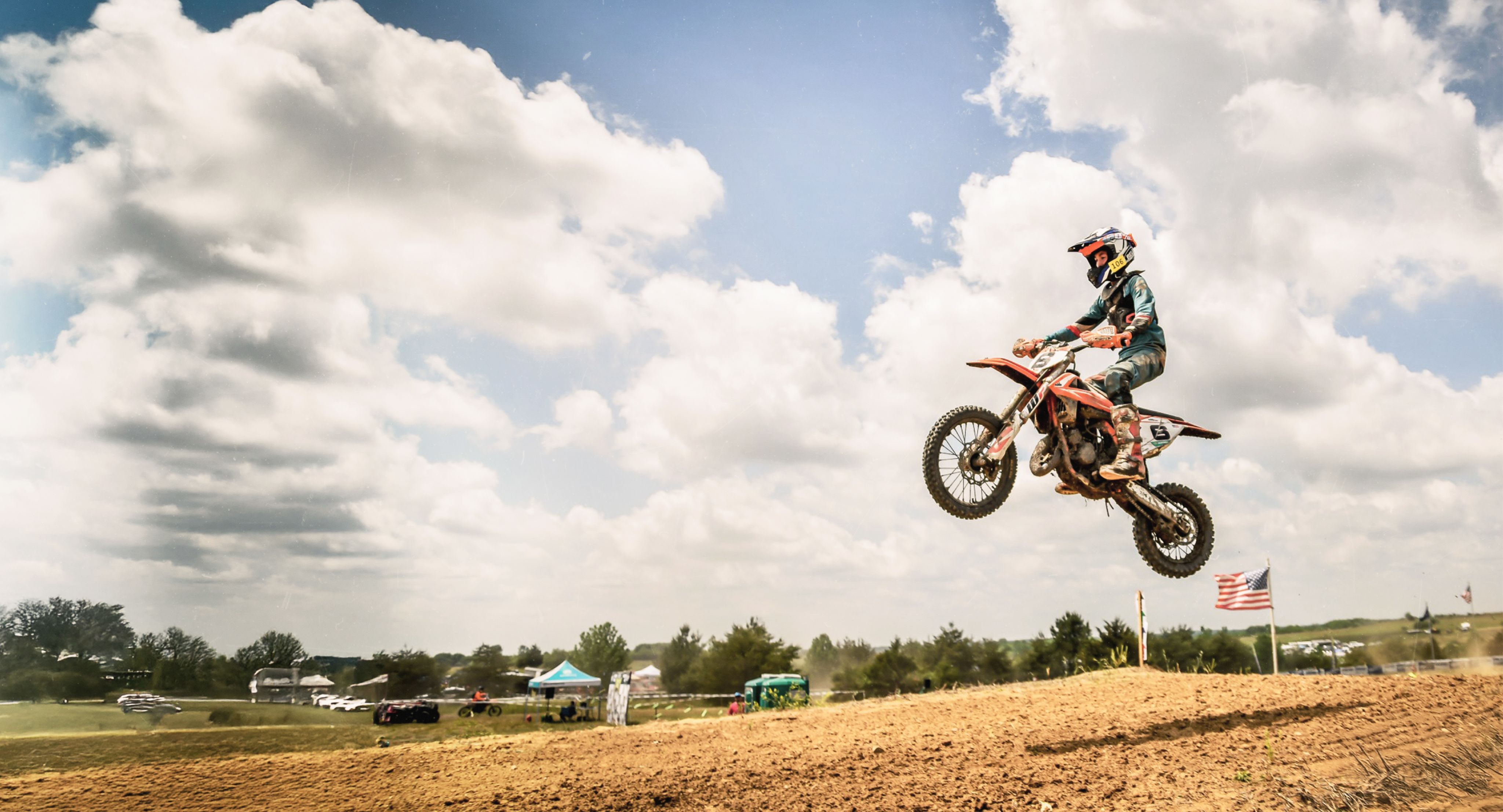
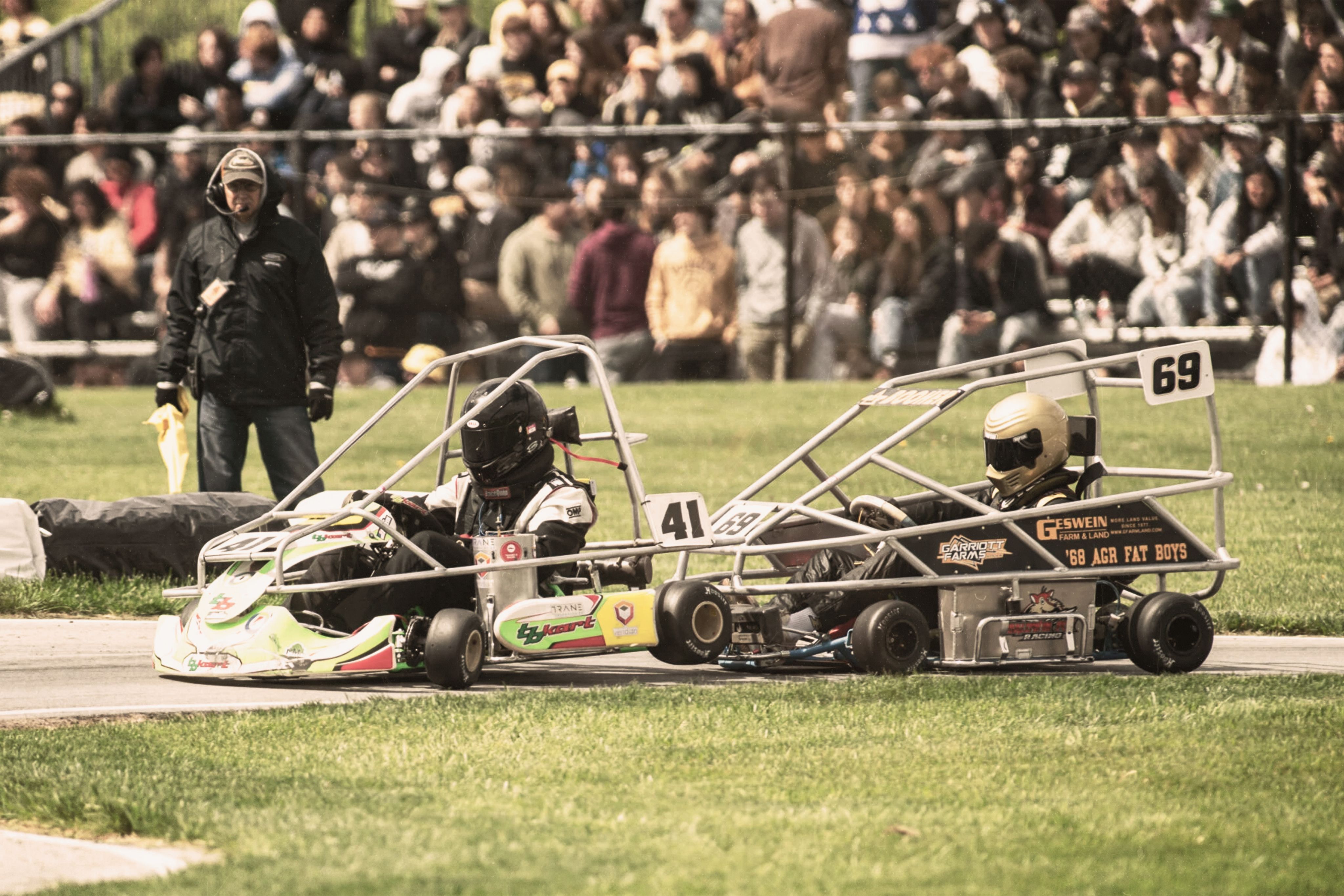
Future in Focus
Following the 2024 race, Joe promptly began preparing for the 2025 Grand Prix by having his go-kart tuned up for another run at the checkered flag.
“Most people don’t realize this is a yearlong project,” he says. “We put a lot of money and strategy into it—everything from testing different tire pressures to various ways of setting up the go-kart to maximize our strategy.”
On October 12, Joe participated in the Purdue Grand Prix Foundation’s inaugural Halloween Hundred, placing fifth out of 25 teams.
“This was the first-ever Purdue race in the fall, and it was really special to be a part of it,” he says. “Each race teaches you something new, whether it’s about your kart, your strategy, or even yourself as a driver.”
And the learning doesn’t stop at the finish line.
“The competition takes place on and off the track because so much engineering and design go into your kart long before the race,” AJ says.
“One could argue that the winning vehicle actually won before the race even began due to the preparation required.”
This entails understanding various factors that contribute to a vehicle’s performance, from the chassis setup and gear ratios to engine design, pipe design, and even the weather.
Looking back to his own experience, Ben agrees that the technical aspects contribute greatly to each driver’s performance, and he’s confident Joe will succeed both on and off the racetrack.
“I’m excited for him and the opportunities ahead,” Ben says. “He’s a bright young man, and I love seeing him continue our family’s story at Purdue. It’s a great school.”
Joe shares his grandfather’s Boilermaker pride.
“Grand Prix is a great experience and a fun event,” he says. “I’m grateful to be the third generation in my family to compete in the race, and I appreciate the opportunity to study at Purdue, which will prepare me for success in whatever I pursue in life.”
Bottom image: Ben Hunter, Joe Booher, and AJ Booher
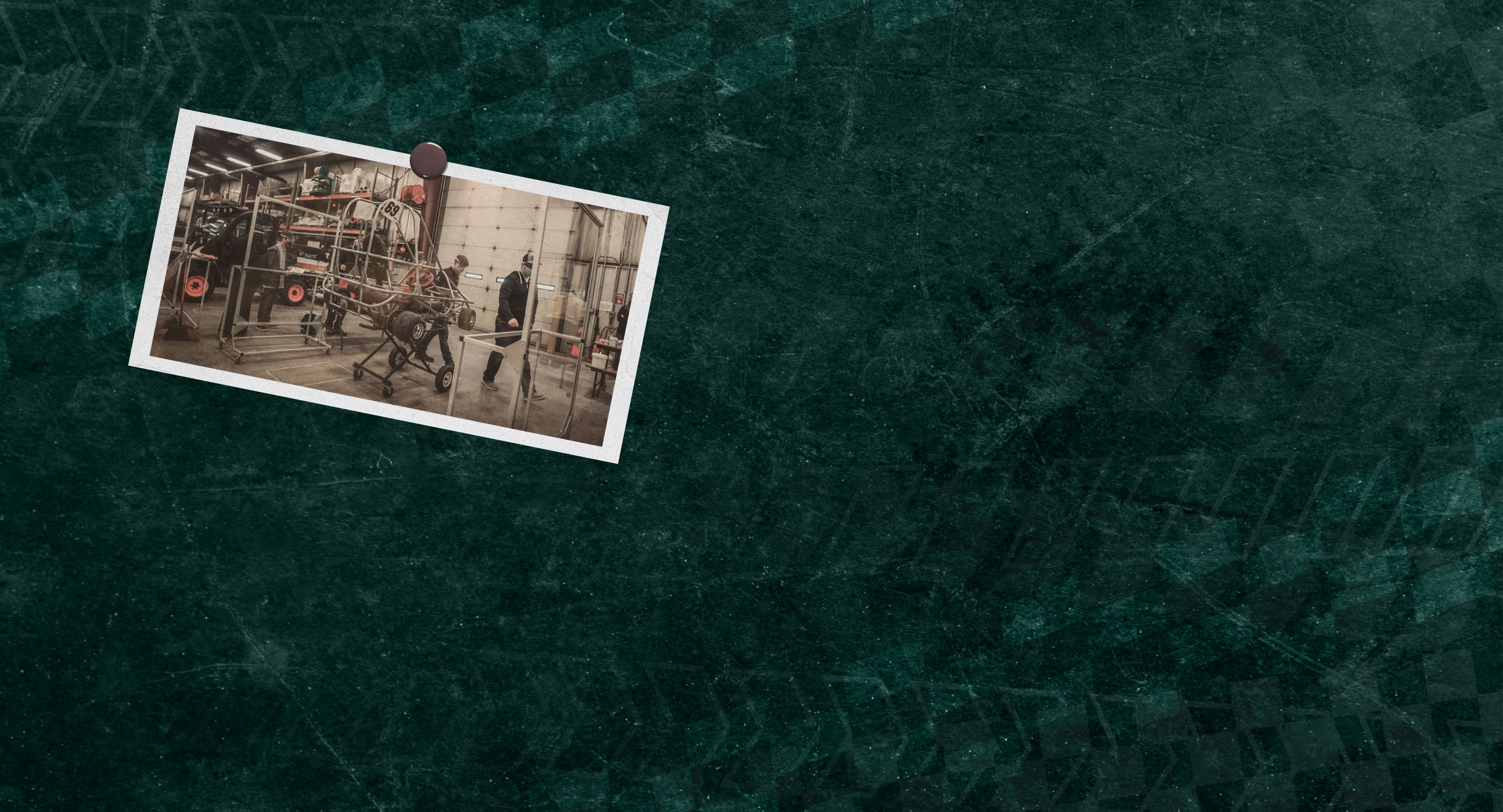
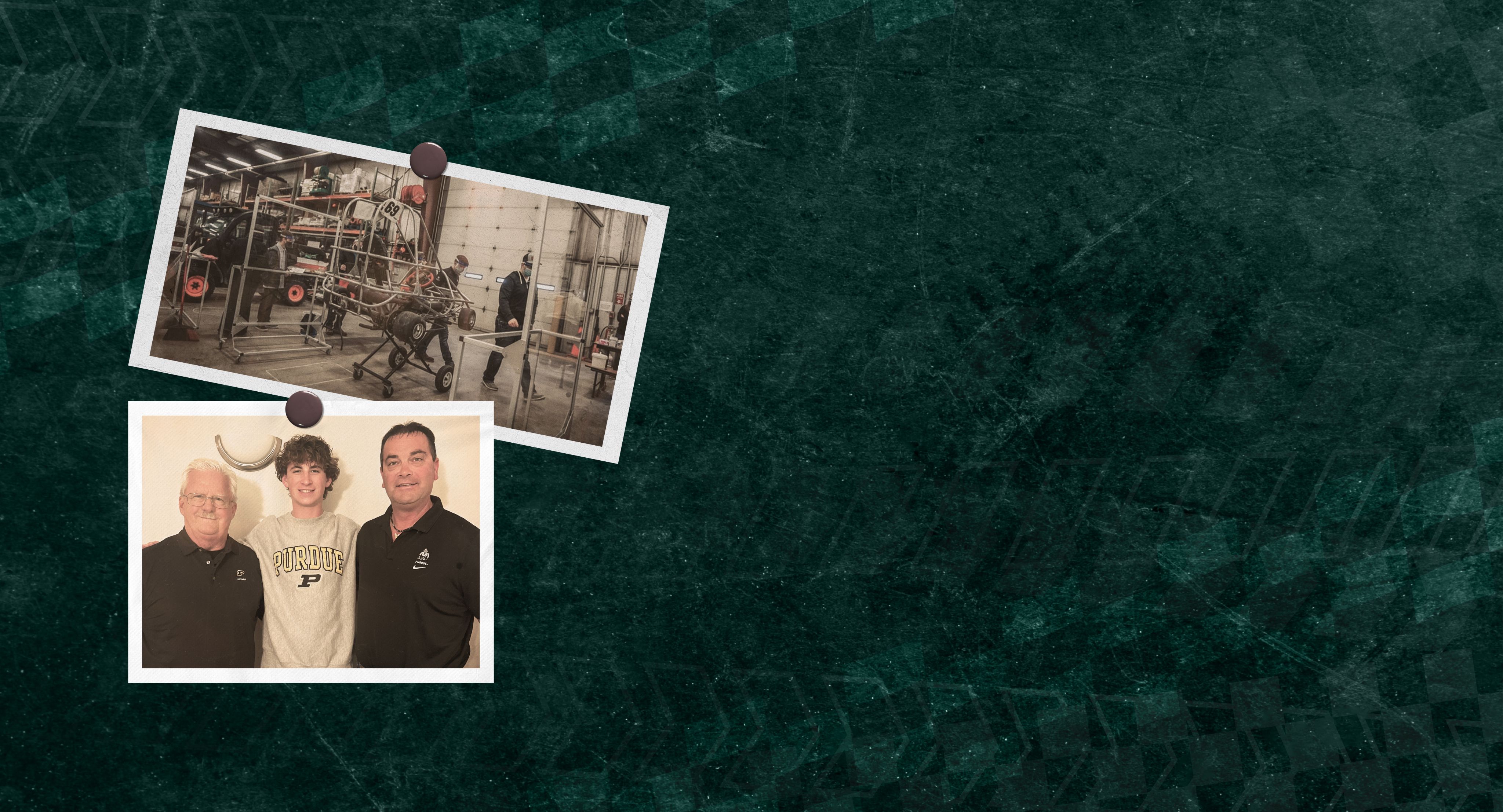
Future in Focus
Following the 2024 race, Joe promptly began preparing for the 2025 Grand Prix by having his go-kart tuned up for another run at the checkered flag.
“Most people don’t realize this is a yearlong project,” he says. “We put a lot of money and strategy into it—everything from testing different tire pressures to various ways of setting up the go-kart to maximize our strategy.”
On October 12, Joe participated in the Purdue Grand Prix Foundation’s inaugural Halloween Hundred, placing fifth out of 25 teams.
“This was the first-ever Purdue race in the fall, and it was really special to be a part of it,” he says. “Each race teaches you something new, whether it’s about your kart, your strategy, or even yourself as a driver.”
And the learning doesn’t stop at the finish line.
“The competition takes place on and off the track because so much engineering and design go into your kart long before the race,” AJ says.
“One could argue that the winning vehicle actually won before the race even began due to the preparation required.”
This entails understanding various factors that contribute to a vehicle’s performance, from the chassis setup and gear ratios to engine design, pipe design, and even the weather.
Looking back to his own experience, Ben agrees that the technical aspects contribute greatly to each driver’s performance, and he’s confident Joe will succeed both on and off the racetrack.
“I’m excited for him and the opportunities ahead,” Ben says. “He’s a bright young man, and I love seeing him continue our family’s story at Purdue. It’s a great school.”
Joe shares his grandfather’s Boilermaker pride.
“Grand Prix is a great experience and a fun event,” he says. “I’m grateful to be the third generation in my family to compete in the race, and I appreciate the opportunity to study at Purdue, which will prepare me for success in whatever I pursue in life.”
Bottom image: Ben Hunter, Joe Booher, and AJ Booher

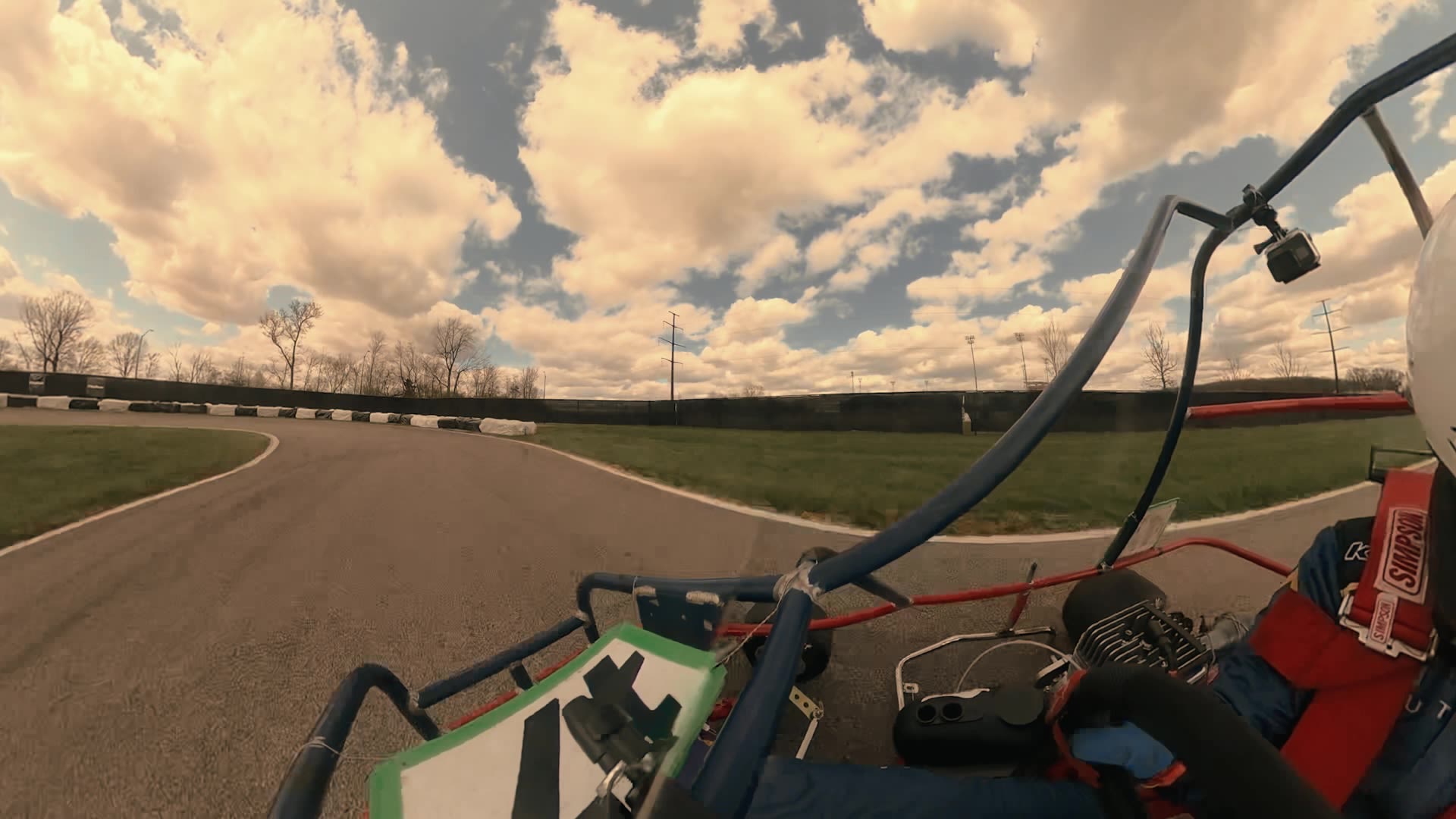

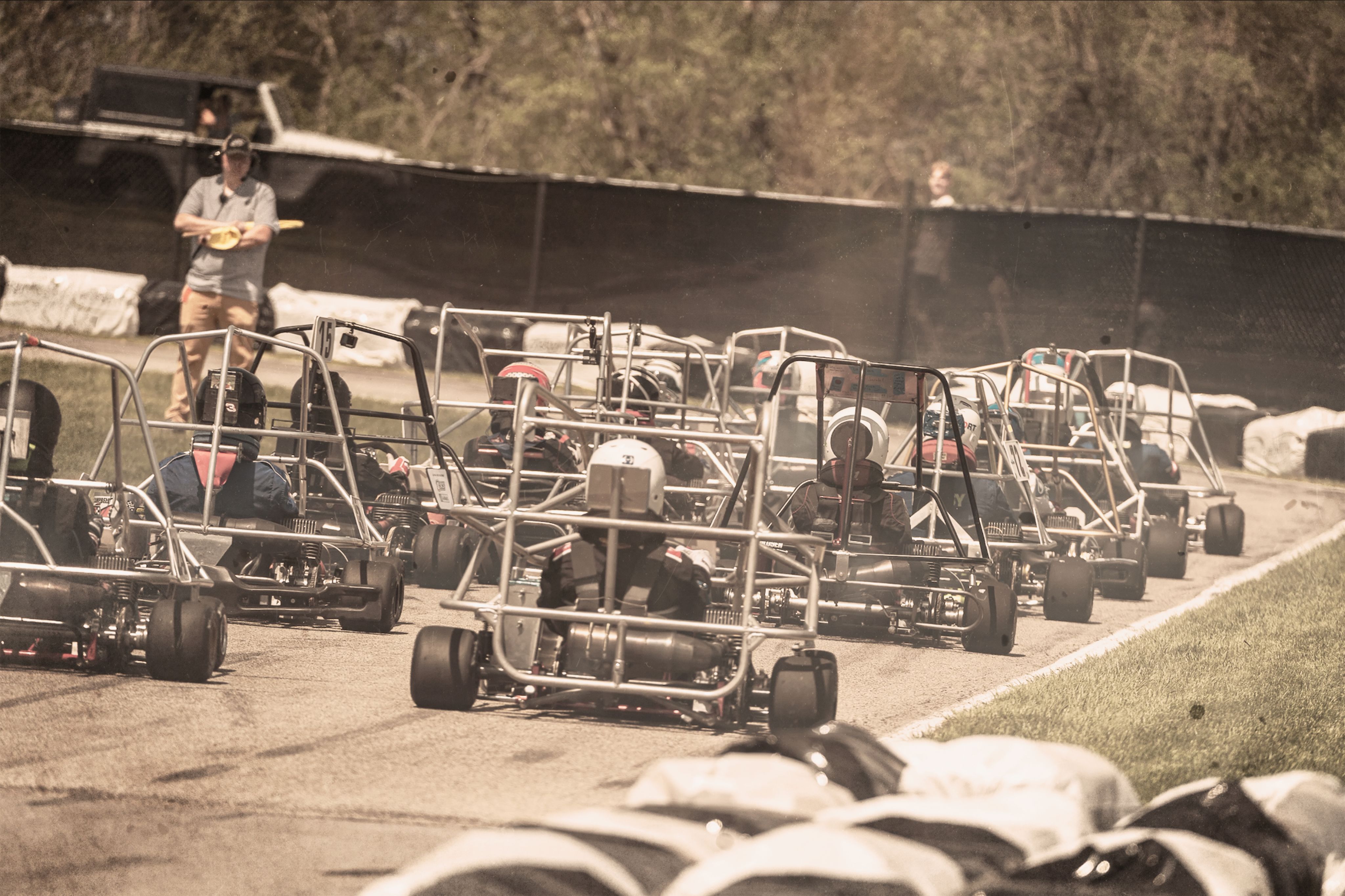
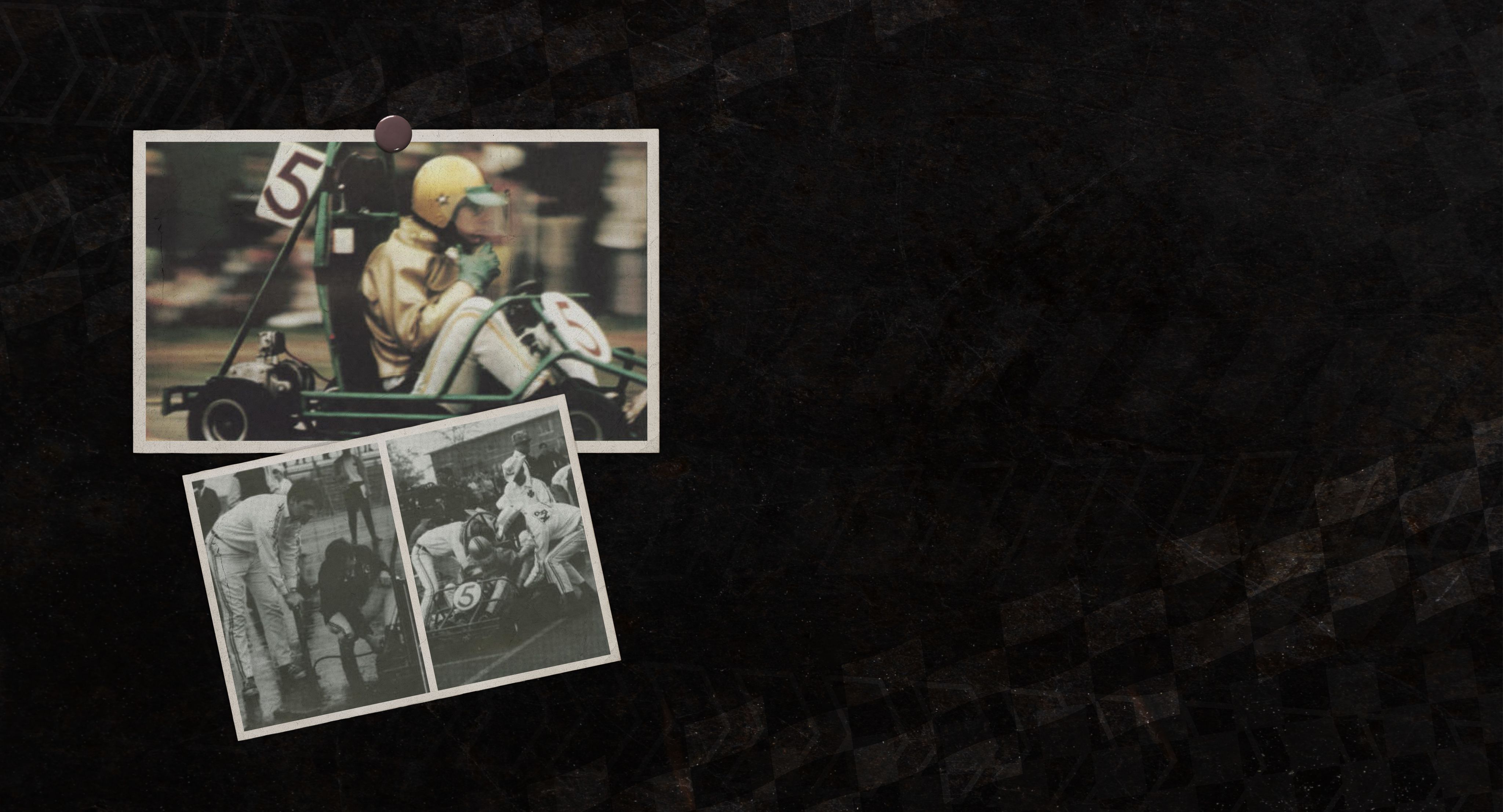
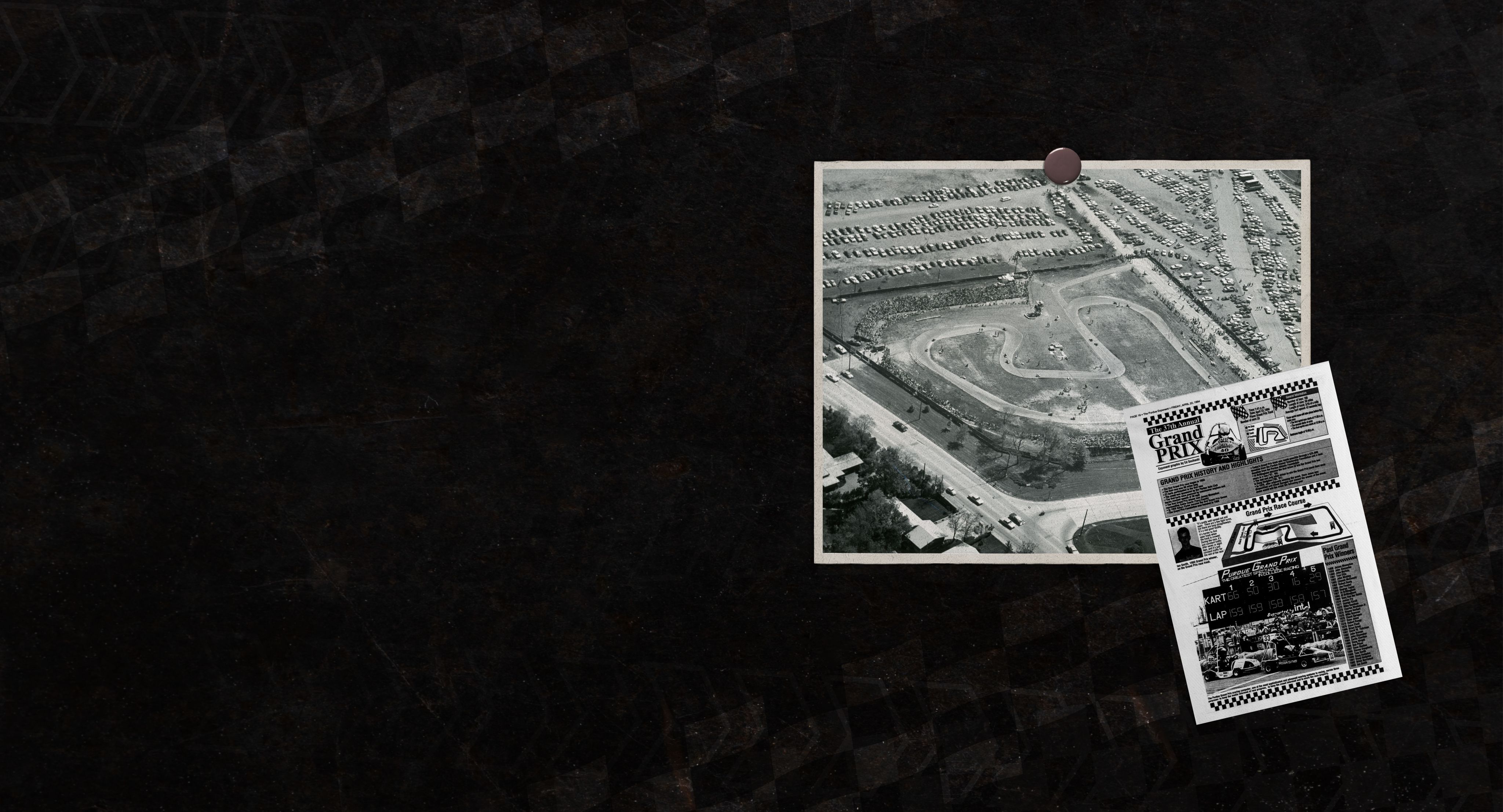
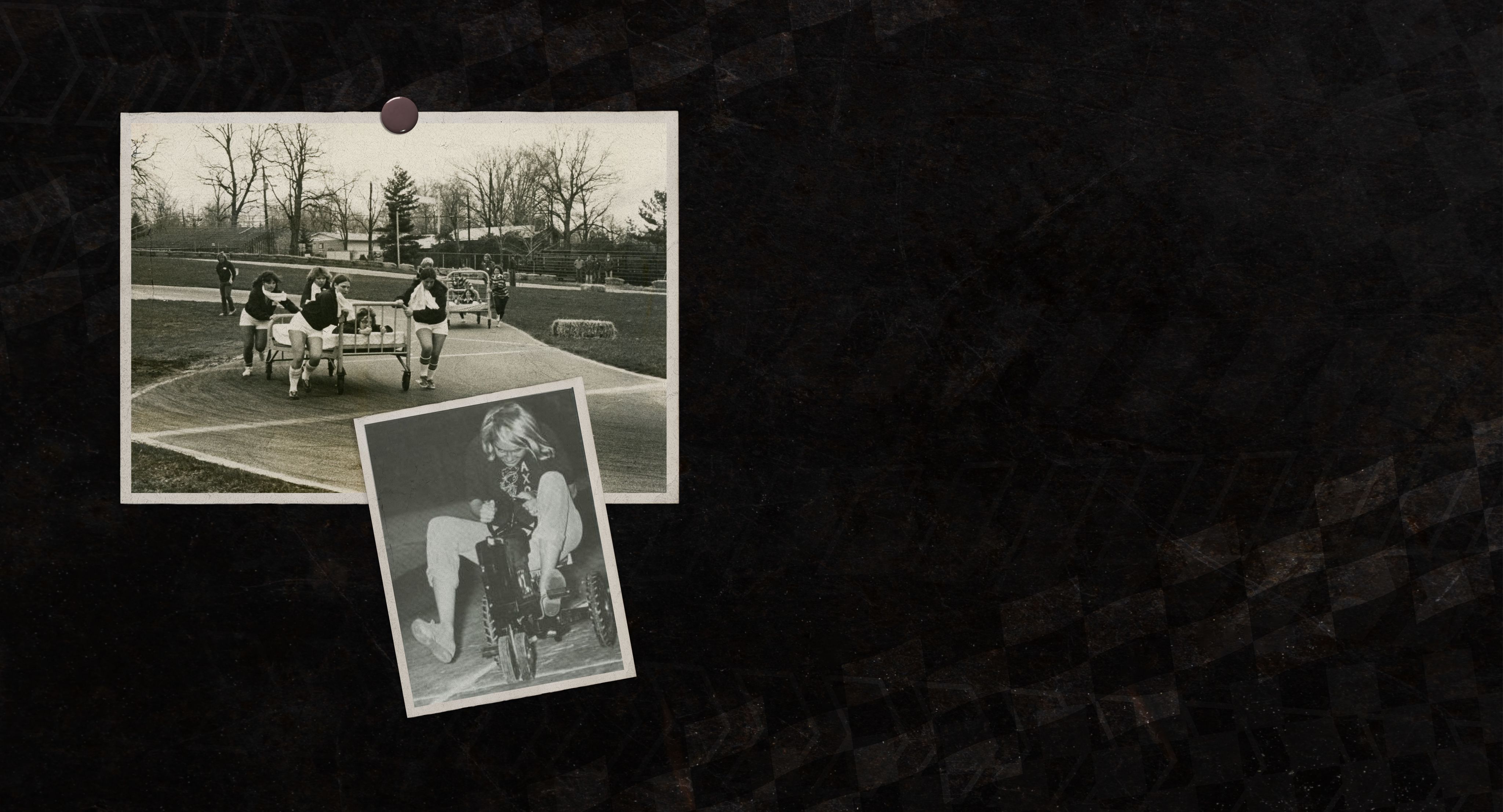
Grand Prix was first held May 17, 1958, in order to raise money for the Purdue Alumni Scholarship Foundation and give engineering students a chance to exercise their creativity and enthusiasm.
The idea for the race is credited to five students who decided it should be patterned after a European road course with a Le Mans start and multiple drivers. Finding sponsorship posed some difficulty, but eventually the Purdue Auto Club agreed to step in. The first race proved so successful that it was featured in Popular Mechanics magazine.
Competing karts were built from scratch with donated lawnmower engines that had been revamped by the student teams. After nearly three hours, James Moneyhun (ECE’59) and his team from the Gable Courts residence hall were declared the winners.
The 1963 Grand Prix marked the first time that the race was run for a specific number of laps. After the disbandment of the Purdue Auto Club in 1965, the Grand Prix Foundation became the sanctioning body of the race.
The foundation continues to coordinate the event today, with a primary goal of raising over $10,000 annually for student scholarships. Averaging a cost of $5,000 and with top speeds close to 50 miles per hour, each team’s kart is still built from scratch. Financial backing is provided by team-solicited sponsorships.
More than 350 students participate in the race, which draws thousands of spectators every April.
On Track
After the inaugural race, the track shifted around campus for several years. Races were held on the oval that once existed in front of Hovde Hall and in the Ross-Ade Stadium parking lot. In 1969, the Grand Prix Foundation moved the race to a new track, northeast of Ross-Ade Stadium, which was carefully modeled after a championship go-kart track in Japan. The race was moved again in 2009 to a $1 million track in the Northwest Athletic Complex. While it resembles its predecessor, the track was made wider and safer for drivers and pit crews. The new track also allowed for an updated scoring system to be installed—one of the most advanced computer scoring systems anywhere in the world of kart racing.
Start Your Tractors…and Beds
In 1966, a prerace event called Les Filles Prix took form—teams of four female students rode toy pedal tractors around a track in Lambert Fieldhouse and, later, Ross-Ade Stadium.
In 1971, Les Filles Prix became a wheeled-bed race and was moved to the Grand Prix track. Teams consisted of five members—four women pushed each bed and one rode on top. By the early 2000s, the race had run its course and was discontinued.
Rear View
Grand Prix was first held May 17, 1958, in order to raise money for the Purdue Alumni Scholarship Foundation and give engineering students a chance to exercise their creativity and enthusiasm.
The idea for the race is credited to five students who decided it should be patterned after a European road course with a Le Mans start and multiple drivers. Finding sponsorship posed some difficulty, but eventually the Purdue Auto Club agreed to step in. The first race proved so successful that it was featured in Popular Mechanics magazine.
Competing karts were built from scratch with donated lawnmower engines that had been revamped by the student teams. After nearly three hours, James Moneyhun (ECE’59) and his team from the Gable Courts residence hall were declared the winners.
The 1963 Grand Prix marked the first time that the race was run for a specific number of laps. After the disbandment of the Purdue Auto Club in 1965, the Grand Prix Foundation became the sanctioning body of the race.
The foundation continues to coordinate the event today, with a primary goal of raising over $10,000 annually for student scholarships. Averaging a cost of $5,000 and with top speeds close to 50 miles per hour, each team’s kart is still built from scratch. Financial backing is provided by team-solicited sponsorships.
More than 350 students participate in the race, which draws thousands of spectators every April.
On Track
After the inaugural race, the track shifted around campus for several years. Races were held on the oval that once existed in front of Hovde Hall and in the Ross-Ade Stadium parking lot. In 1969, the Grand Prix Foundation moved the race to a new track, northeast of Ross-Ade Stadium, which was carefully modeled after a championship go-kart track in Japan.
The race was moved again in 2009 to a $1 million track in the Northwest Athletic Complex. While it resembles its predecessor, the track was made wider and safer for drivers and pit crews. The new track also allowed for an updated scoring system to be installed—one of the most advanced computer scoring systems anywhere in the world of kart racing.
Start Your Tractors…and Beds
In 1966, a prerace event called Les Filles Prix took form—teams of four female students rode toy pedal tractors around a track in Lambert Fieldhouse and, later, Ross-Ade Stadium.
In 1971, Les Filles Prix became a wheeled-bed race and was moved to the Grand Prix track. Teams consisted of five members—four women pushed each bed and one rode on top. By the early 2000s, the race had run its course and was discontinued.






